APUSH Periods 1 & 2
1/106
Earn XP
Description and Tags
Name | Mastery | Learn | Test | Matching | Spaced |
|---|
No study sessions yet.
107 Terms
Pueblo Indians
These Native Americans, living in what is now Arizona and New Mexico, settled in permanent villages and perfected the techniques of desert farming. Their descendants, the Hopi and Zuni civilizations, had practiced agriculture there for the previous 3,000 years, but drought brought about their decline. During the peak of the region's culture, between 900 ad and 1200 ad, these people built great planned towns with large multiple-family dwellings (Pueblo Bonita was five stories tall and had over 600 rooms; no larger buildings were constructed until New York City began to do so in the 1880s!), constructed dams and canals for agriculture, had an elite class of leaders, and conducted trade with people as far away as Central America and the Mississippi Valley (Cahokia).

Tongva
The Native American people who lived in parts of southern California, and specifically what is now Los Angeles County, at the time of Spanish colonization. An estimated 5,000 to 10,000 lived in the region when the first Spanish settlers arrived in 1781 to establish Los Angeles. There are 31 known sites believed to have been their villages, each having had as many as 400 to 500 huts.
Haudenosaunee (Iroquois Confederacy) Pronounced "hoe-dee-no-SHOW-nee"
This is the name of the confederacy of six native nations--the Mohawks, Oneidas, Cayugas, Senecas, Onondagas, and Tuscarora--traditionally living in what is now New York and Pennsylvania and led by male representatives chosen annually by women of the six nations. Extended families of the same clan lived in long houses big enough for about sixty people, and their permanent villages could be as large as 3,000 people. They practiced a mix of agriculture (three sisters), hunting, and gathering and grew heavily involved in the fur trade after European arrival. Fun fact, the modern sport of Lacrosse originated with this confederacy.
Animism
This is the belief that spiritual power suffuses the world and sacred spirits can be found in all kinds of living and inanimate things--animals, plants, trees, water, and wind. This was a very common belief of many Native American tribes, despite the fact that the most striking feature of Native American society a the time of European contact was its sheer diversity. Each group had its own political system and set of religious beliefs, and North America was home to literally hundreds of mutually unintelligible languages. Nevertheless, the diverse Indian societies were similar in that their lives were steeped in religious ceremonies often related to farming and hunting. Despite this deeply spiritual culture, nearly all Europeans arriving in the New World quickly concluded that Indians were in dire need of being converted to a true, monotheistic, Christian faith.

Matrilineal Societies
Societies that trace descent through the mother's line, rather than the father's line (as was the custom in Europe). Native societies were highly gendered but much more equal than the European system of gender relations. In most native communities, women had responsibility for farming, storing and preparing food, running households, and participating in councils and decisions about making war and peace. Europeans often viewed Indian women as mistreated (because they did most of the farming) and Indian men as lazy (because they spent a lot of time hunting, which was considered a leisure activity in Europe).

Established Church
This is a church that is recognized by law as the official church of a state or nation. In the early modern era, each nation in Europe had one of these, and it decreed what form of religious worship and belief were acceptable. Dissenters faced persecution by the state because religious uniformity was thought to be essential for public order. Wars of religion, often between Protestant and Catholic sects of Christianity, racked Europe in the 1500s and 1600s, serving as both context and cause of European colonization of, and migration to, the Americas. The modern notion of "religious freedom," in which an individual's religious beliefs and practices are a matter of personal choice, is one of the central tenants of a liberal society, and it would not begin to develop until the American Revolution (1st Amendment).
Christian Liberty
The idea held by many European Christians, both Protestant and Catholic, that freedom was the ability to do what was moral and good. In other words, someone was free when they embraced the teachings of Christianity, abandoned a life of sin, and liberated themself from their own self-destructive tendencies. Since the Indians did not conform to this idea, many Europeans viewed them as savage heathens who needed to be forced into a new religion and way of life. (This term is essentially synonymous with the Puritan concept of "moral liberty.")
hierarchical society
A society in which people have different ranks or positions, usually inherited from their parents, which determine the kind of work they and their children can do, where they live, how they dress, and how much status and respect they are due. Almost all societies (especially large ones) since ancient history were structrued this way. In these, liberty was believed to come from knowing one's place and fulfilling the duties appropriate to one's position. Inherited positions and ranks were rejected in the U.S. (at least in theory) after the philosophy of liberalism and the ideal of equality emerged during the American Revolution.
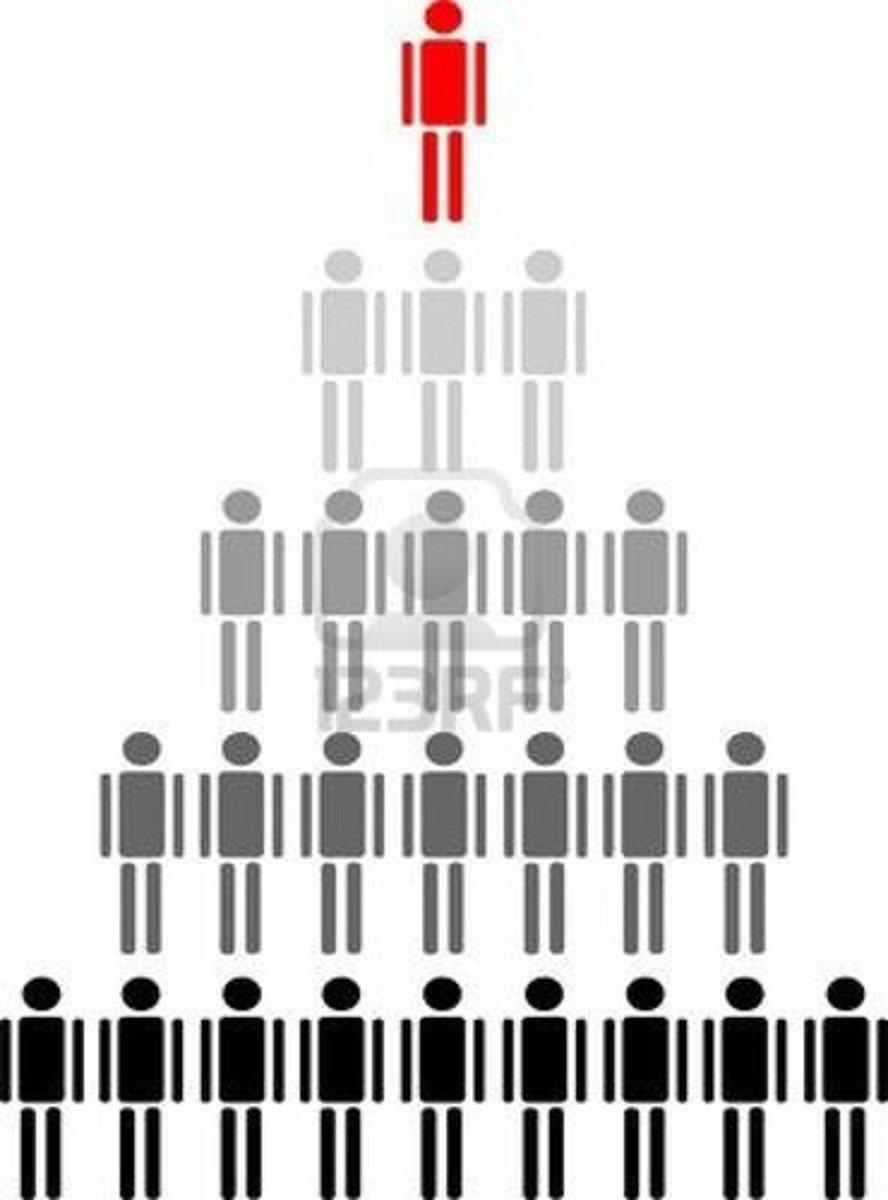
The Great Chain of Being
The widespread world view among Europeans, before the Enlightenment, that claimed every being occupied a place in a hierarchical structure decreed by God. With God at the top, the social order descended down through angels, humans, animals, and plants, and finally to minerals. Each link in the chain was sub-divided further into its component parts: For example, the human order moved from King down through Aristocracy, down through Clergy, and down further through artisans, peasants, and slaves. Crucially, if someone challenge their place in this social order, they were in effect violating God's law. This world view was rejected during Enlightenment as a fundamental belief in human equality emerged (a core principle of the philosophy of liberalism).

Deference
An ingrained social tradition in which ordinary people assume that only their "superiors"--with more wealth, education, and social prominence--possessed the right to hold public office. Ordinary Americans--farmers, merchants, artisans, indentured servants, women, the enslaved, etc.--assumed both their own inferiority as well as the supposed superiority of the elites in social and political affairs, where powerful Americans felt confident exercising their authority. This tradition was prominent in throughout the world during the Colonial Era, and it finally began to fade with the emergence of the belief in human equality during the Enlightenment and the America Revolution. Since then, Americans have prided themselves on being egalitarian and entirely anti-deferential.
Divine Right of Kings
The pre-Enlightenment belief that God had created states and had given Kings (and those of Royal birth) the right to rule over others. According to this belief, the King held absolute power and authority over the people, just as God had absolute power and authority over the universe. The people were bound to obey the King just as they were bound to obey God. Opposition to the King was understood as both treason and a mortal sin. This belief followed from the theory of Great Chain of Being. Eventually, during the 17th and 18th centuries, this idea was rejected by Enlightenment philosophers (such as Thomas Hobbes and John Lock) who insisted on the right of popular sovereignty.
The Sixteenth century
The 1500s (Misconception alert: When you come across a century term in your reading, it's always a good idea to translate it into years in your head. For example, if you read the term 16th century, think the 1500s.)
The Age of Exploration
The "Age of Exploration," sometimes also called the "Age of Discovery," is an informal and loosely defined term for the early modern period approximately from the 1400s to the 1700s in European history, in which seafaring Europeans explored regions across the globe, most of which were already inhabited. It was triggered in part by the fall of Constantinople (now Istanbul) to the Ottoman Empire in 1453, after which Christian Europeans sought to cut out the Muslim middlemen of the land-based Silk Road trade by finding new water routes to India, China, and the islands of the East Indies which were the sources of silk, tea, spices, porcelain, and other luxury goods on which international trade of the early modern era centered. With the aid of new long-distance ships called "caravels" as well as navigational devices such as the compass and the quadrant, the Portuguese first established a shipping route around the Southern tip of Africa in the late 1400s. Others would follow, and the European conquest of America started as an offshoot of this quest for a sea route to Asia.

Conquistadores
Spanish explorers who travelled to the New World motivated by wealth, national glory, and the desire to spread Christianity. They reshaped the New World by conquering, converting, and killing natives.
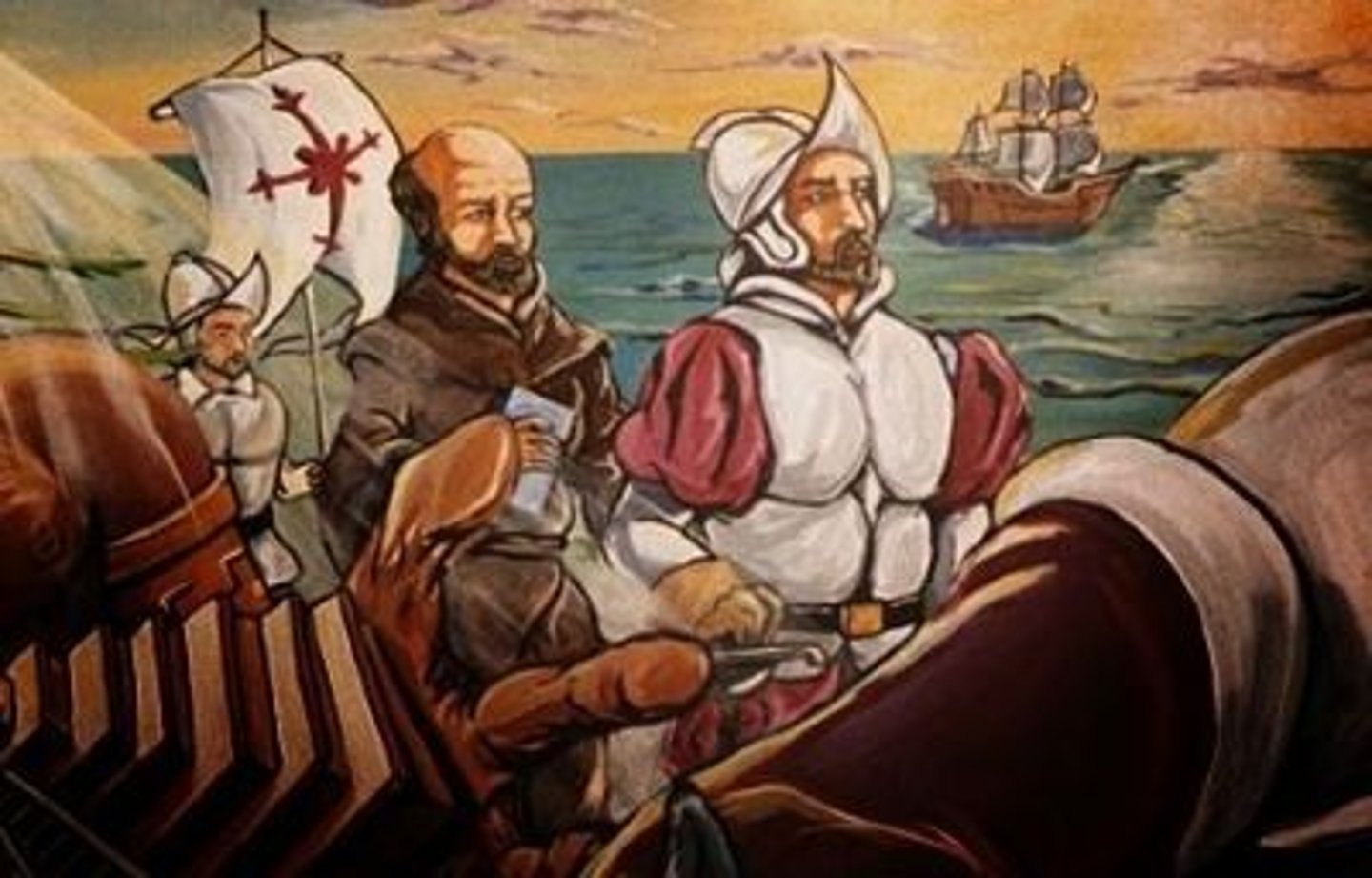
Christopher Columbus
An Italian born navigator who found fame when he--sailing for Spain-- landed in the Americas in 1492 with three ships: the Nina, the Pinta, and the Santa Maria. He had sailed in search of a western water route to Asia, and he was convinced that he was successful and that what he had found was an extension of China.

The Colombian Exchange
This transatlantic flow of people and goods (including plants, animals, and diseases), beginning with Columbus's voyages in 1492, altered millions of years of evolution. Plants, animals, and cultures that had evolved independently on separate continents were now thrown together. Products introduced to Europe, Africa, and Asia from the Americas include corn, tomatoes, potatoes, tobacco, and chili peppers, while people brought to the Americas wheat, rice, watermelons, horses, pigs, goats, ad sheep. This process has profoundly reshaped the lives of all people and ecosystems on earth in the last half millennium.

The Great Dying
The massive population collapse among Native Americans in the centuries following 1492 caused by the spread of old-world diseases as part of the Columbian Exchange. Native American communities, who had no natural immunity due to their isolation on the American continents for thousands of years, were exposed for the first time to diseases, such as measles, smallpox, influenza, and the bubonic plague, that had developed and circulated on the Afroeurasian continents. It is impossible to know the precise extent of damage of these diseases because determining the pre-1492 population of the Americas yields wildly different estimates; nevertheless, most scholars estimate that roughly 90% of the Native Americas died from wave after wave of disease in the three hundred years after Columbus.
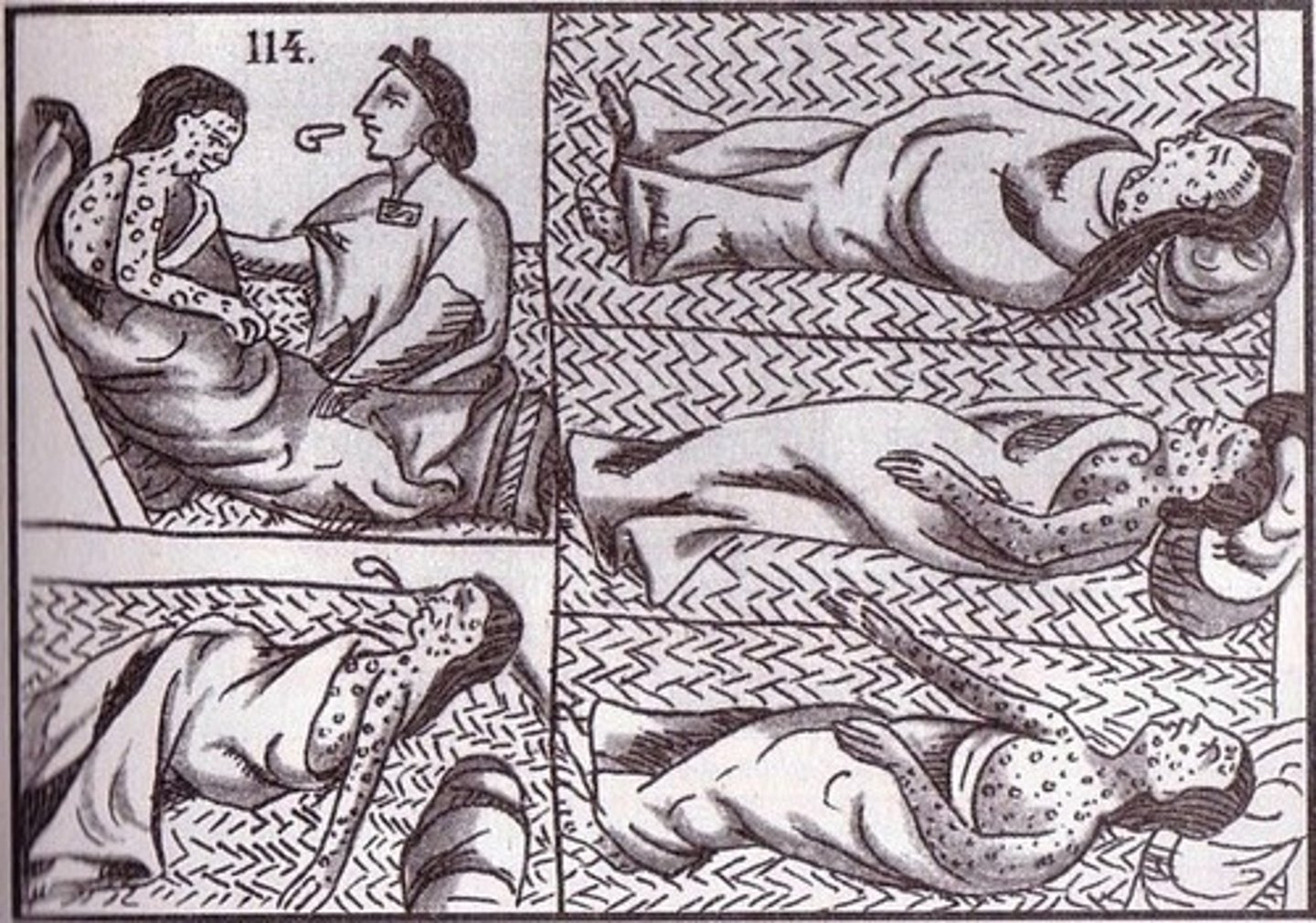
New Spain
This term refers to the Spanish colonies in the Americas, beginning with Columbus's arrival in 1492 and lasting until the early 1800s. With its capital in Mexico City, it included parts of Southwestern portions of the modern-day United States, all of Mexico and Central America, much of the Caribbean, and most of South America (except Brazil, which Portugal colonized) Spanish efforts to extract wealth from the land led them to develop institutions based on subjugating native populations to use them to labor in gold and silver mines and on large farms, converting them to Catholic Christianity, and incorporating them, along with enslaved and free Africans, into Spanish colonial society. The Spanish colonies were more urban than other European colonies in the Americas. And because the Spanish crown governed their colonies in a top-down manner through a viceroyalty system, they were also much less democratic.
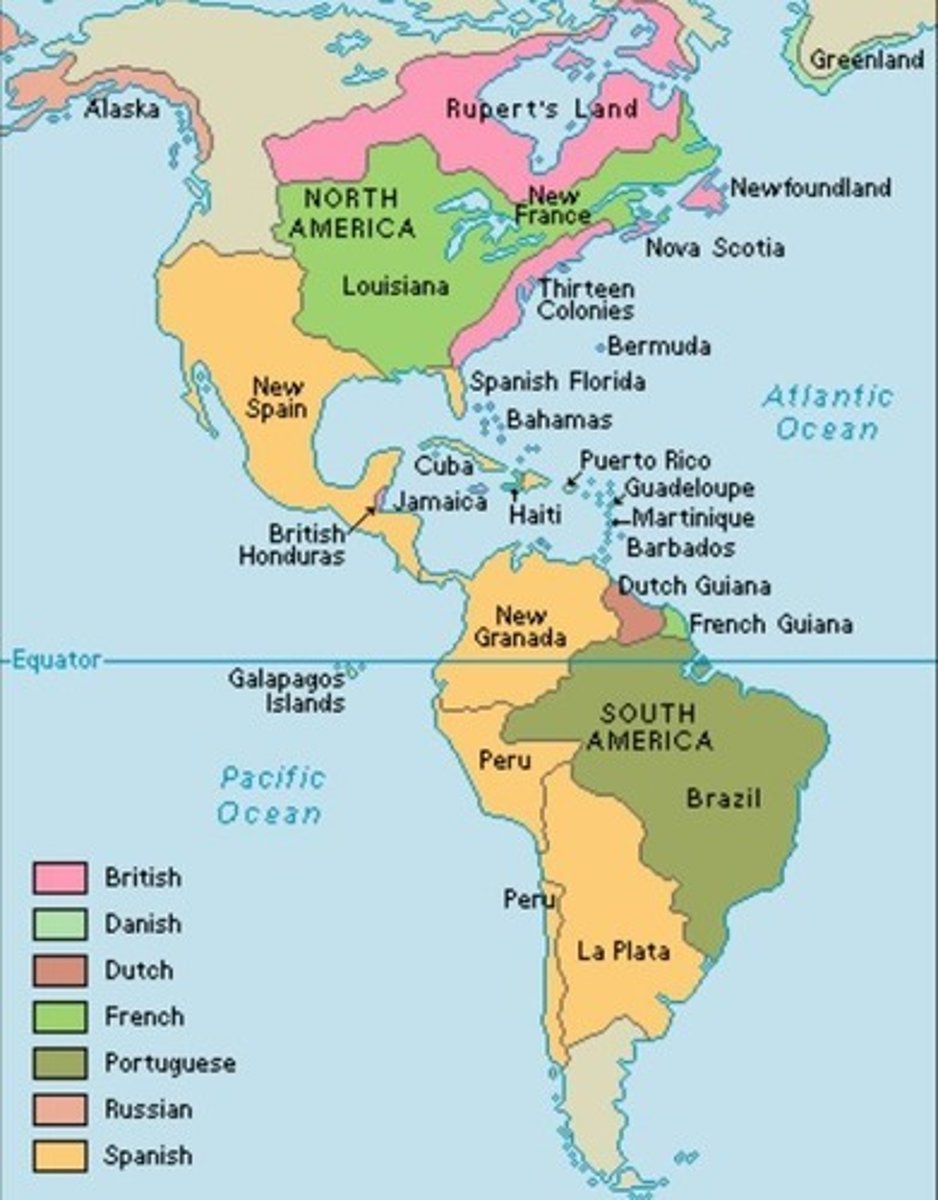
Mestizos
Persons of mixed origin due to the intermarriage of Indians and Spanish colonizers. They caused Spanish America to evolve into a hybrid culture. The marriage between Indians and colonizers indicated somewhat more equal status than in the British colonies.
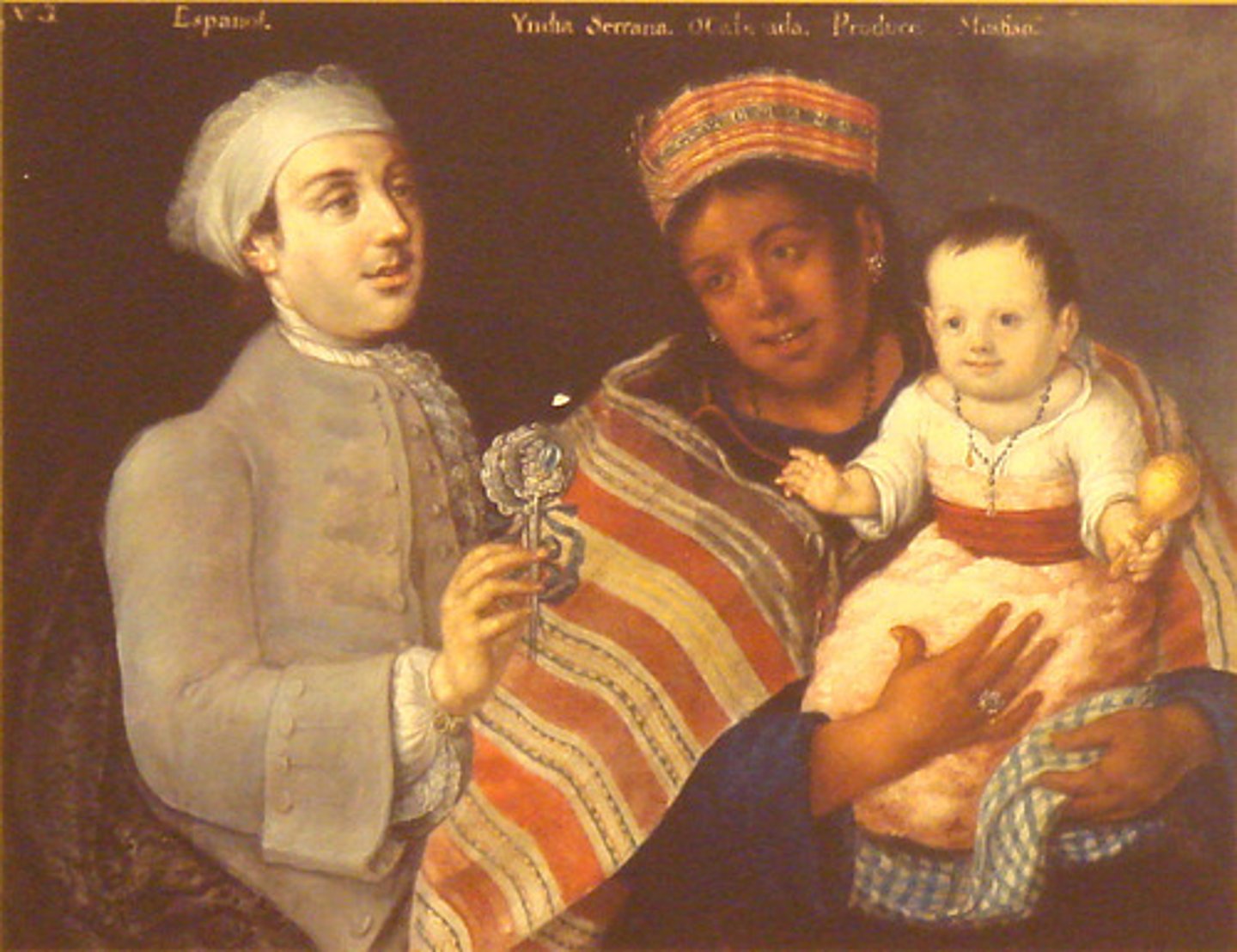
Martin Luther and his Ninety-Five Theses (1517)
When this German priest wrote this list of criticisms of the Catholic Church in 1517, he launched a revolution in Western history known as the "Protestant Reformation." His criticisms divided the Catholic Church (which had been the central Christian institution since the time of Ancient Rome in the first century AD) and led to the creation of numerous new "Protestant" Churches (in "protest" of the Catholic church) in Europe. Over a century of bloody warfare and political conflict between Protestants and Catholics ensued all over Europe. This period of deadly religious conflict and tension is the context in which different European nations aimed to spread their own branch of Christianity into the Americas as well as the context in which the Puritans (one of the many new Protestant faiths) would later flee England in search of a place where they could worship without being persecuted. (Misunderstanding alert: Protestantism and Catholicism are both Christian faiths!)
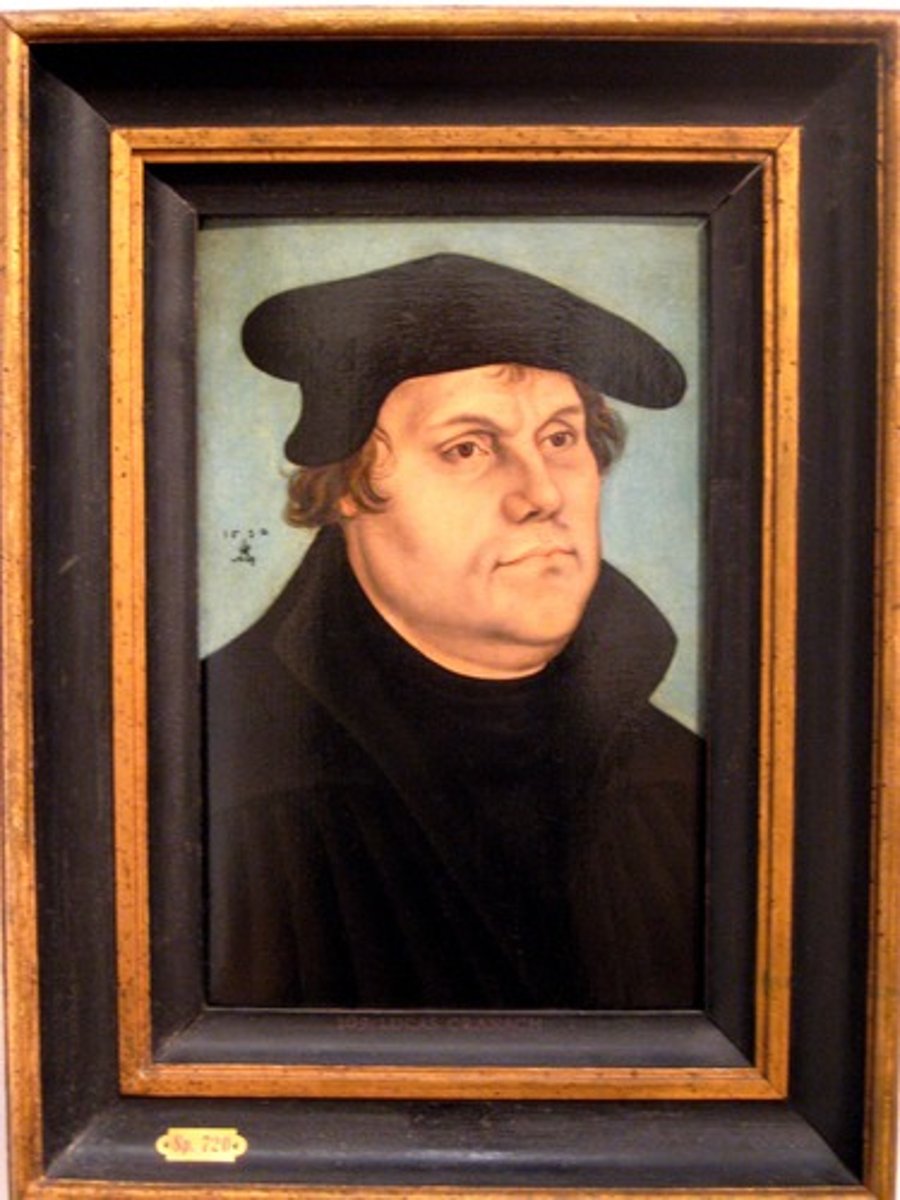
Bartolomé de Las Casas
The Spanish priest who wrote "A Very Brief Account of the Destruction of the Indies" in 1552 in which he criticized Spanish colonists' brutal treatment of Indians and argued that "The entire human race is one." His portrayal of Spain as a uniquely cruel colonizer lead both to the repartimiento system (which reformed the encomienda system) but also the "Black Legend," which diminished Spain's national glory and changed how other Europeans in the New World treated Indians and.

The encomienda system
The system used by the Spanish during colonization in order to exploit, often brutally, American Indians for their labor. The Spanish monarchy would grant tracts of land in the New World to Spanish settlers--including the right to use the native inhabitants of that land for labor and for mining precious metals, a portion of which they sent back to the Spanish monarchy.
The Repartimiento System (1550)
Spain replaced their encomienda system in 1542 with these "New Laws," largely because of Las Casas's efforts. They commanded that Indians no longer be enslaved, but they also required Native towns to provide a fixed amount of labor each year on Spanish nines or farms. As tributary towns, they were ruled by Native leaders and lived according to their own laws and customs, as long as they paid their annual tribute to Spain.
The Black Legend
The idea that Spanish colonizers in New Spain were uniquely cruel compared to other European colonizers. It was spread by Las Casas's depiction of Spanish America, and was used to justify English imperial expansion. It led to intense criticism of the Spanish and lessened their national glory. It also further deteriorating their relationship with the Indians.
The Pueblo Revolt (1680)
This 1680 uprising of native people in the Spanish colony of New Mexico in New Spain successfully (but only temporarily) drove the Spanish from New Mexico and reestablished indigenous freedom from the Spanish conquest. They rebelled due to forced labor and Spanish attempts to stamp out traditional indigenous religious ceremonies. Let by an Indian named Popé, 2000 warriors rose up, killed 400 Spanish colonists, including 21 Catholic missionaries, and destroyed farms, missions, fruit trees, cattle, and images of Christ. After twenty years, the Spanish reconquered the region, but this time they were more tolerant of native religious practices.
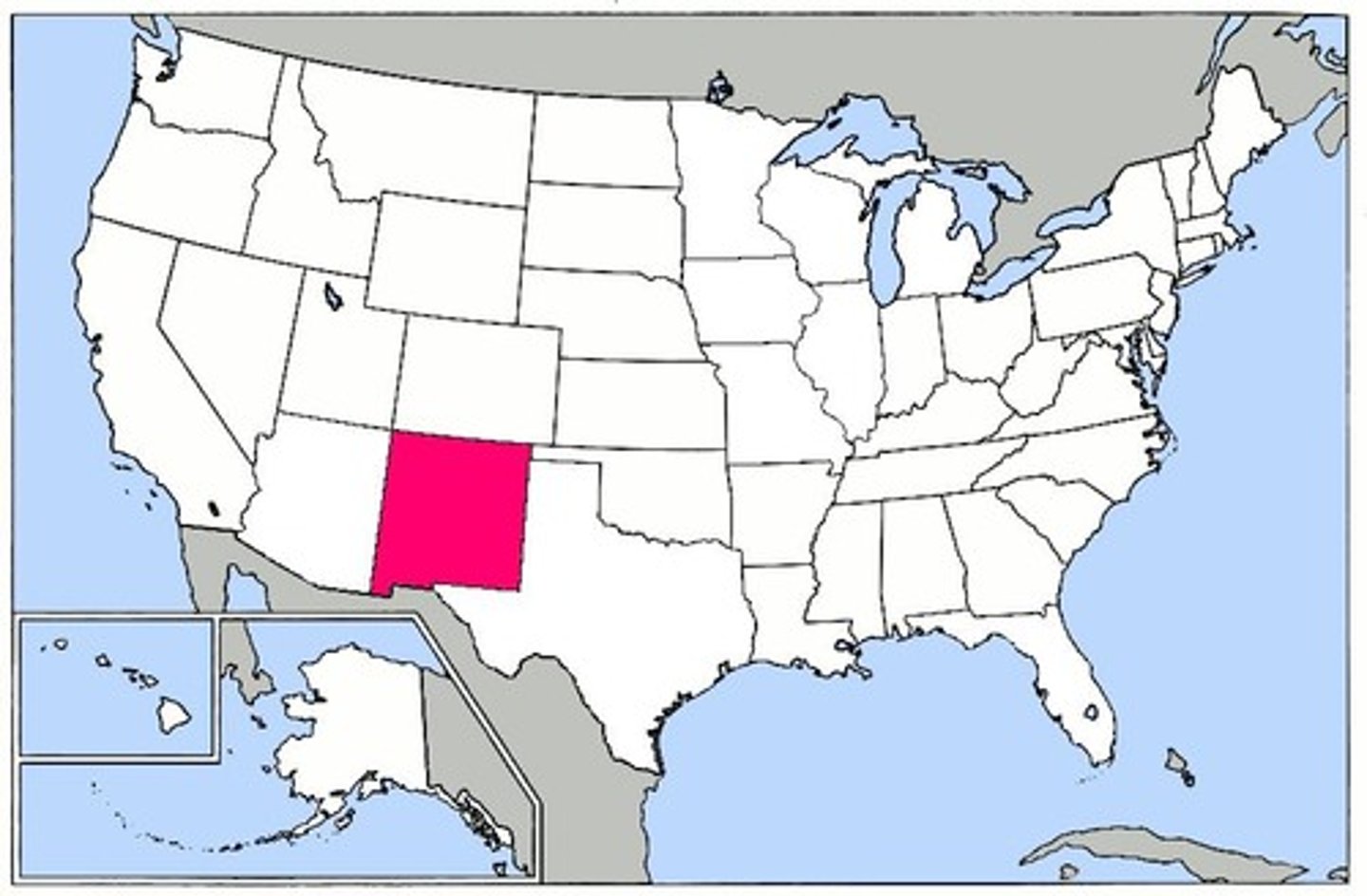
New France
This was the territory colonized by France in North America, beginning with the exploration of the Saint Lawrence River by Jacques Cartier in 1534 and ending with the cession of New France to Great Britain and Spain in 1763 under the Treaty of Paris. The French were primarily interested in the territory as a commercial venture, never establishing large numbers of colonists, and instead relied on trade alliances and intermarriage with American Indians to build economic and diplomatic relationships (to challenge the English settlements) and acquire furs and other products for export to Europe.

The Fur Trade
The main economic activity in New France in which French, Dutch, and sometimes English traders would exchange metal goods like kettles and guns, ceramic pots, and alcohol with Native American trading partners for animal furs, especially beaver (which were used to make popular winter clothing in Europe). This relatively cooperative relationship contrasted with the relationships the Spanish and English developed with Native Americans.
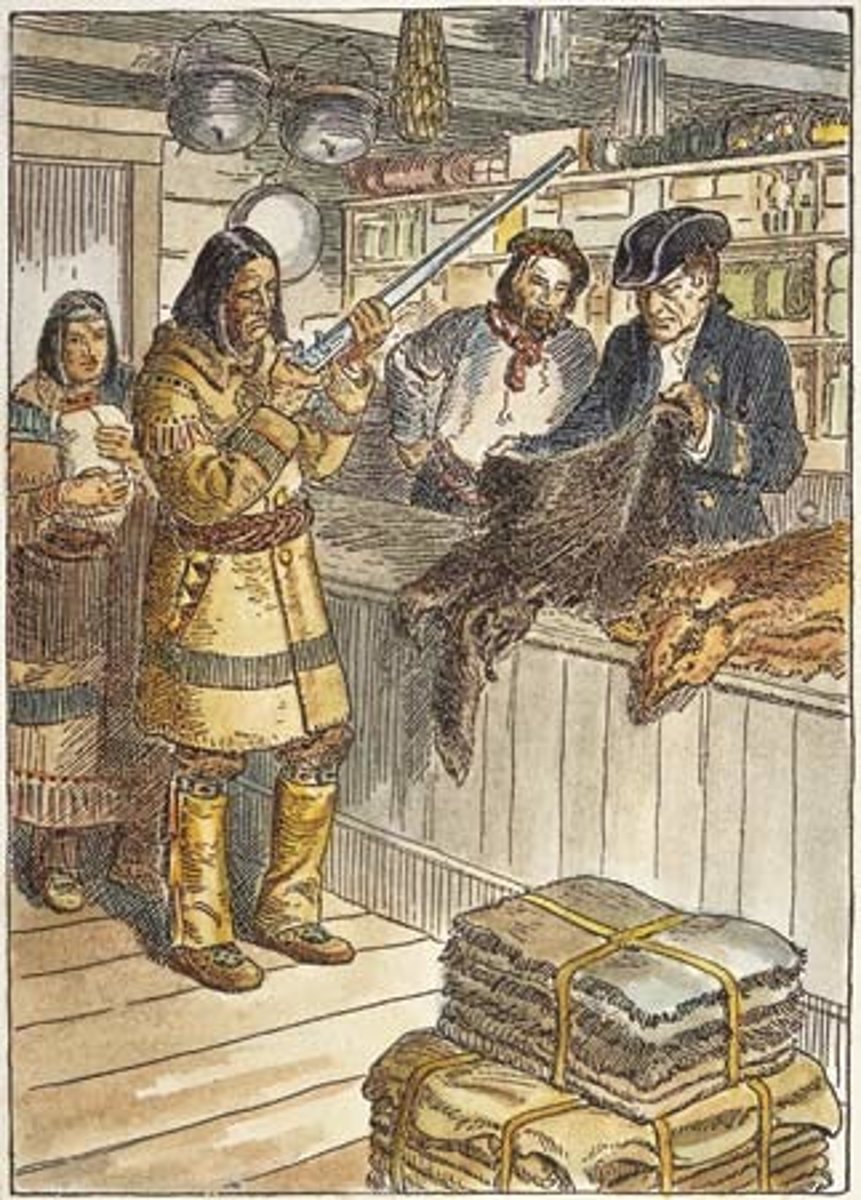
Métis
The children of marriages between French traders and Indian women, many of whom became guides, traders, and interpreters. Compared to the British, the French viewed the Indians as relatively equal to them, which lead to their intermixing in marriages. They encouraged Indians to join their society, contrasting their treatment as slaves by Spanish colonists.
New Netherland
The Dutch colonial effort in and around what is now New York and New Jersey involved relatively few settlers and relied on trade alliances and intermarriage with American Indians to build economic and diplomatic relationships and acquire furs and other products for export to Europe. This Dutch settlement was conquered and taken by the English in the 1660s.
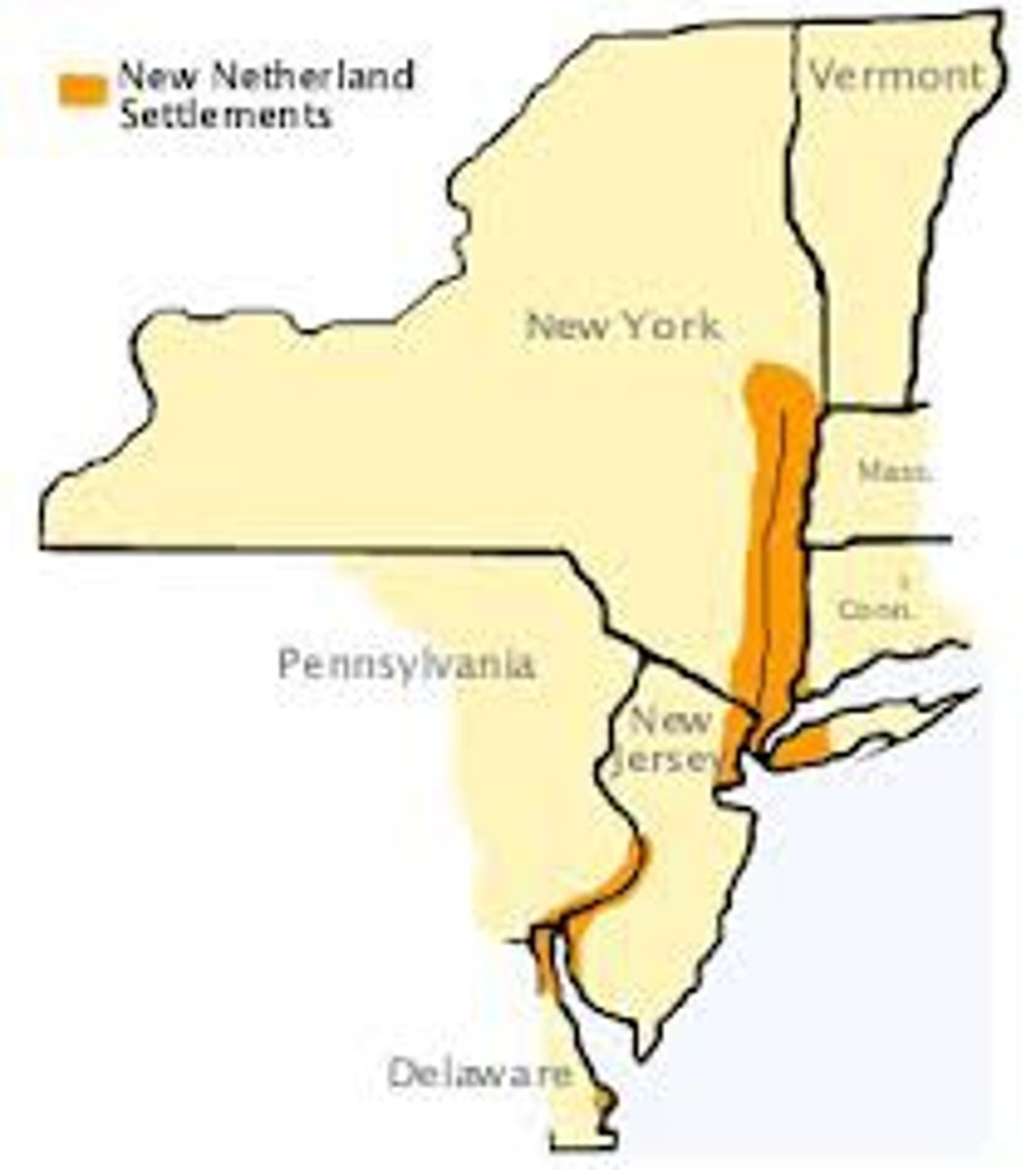
Dutch Religious Freedom
After the Protestant Reformation, the Dutch (the term for people living in the Netherlands) had come to pride themselves on their devotion to liberty, enjoying two freedoms not recognized elsewhere in Europe: the freedom of the press and the freedom of private religious practice. The Dutch colony of New Netherland, which later became New York after the British took possession of it, dealt with religious pluralism in ways quite different from other colonies. Religious dissent was tolerated as long as it did not involve open and public worship. While New Netherland did have an established church (which everyone was required to support through taxes), no one was required to attend it, nor was anyone executed for holding the "wrong" religious beliefs (as happened in Puritan New England and many places in Europe).
The Enclosure Movement
The 16th and 17th-century process in which English landlords evicted small farmers and fenced in the "commons" (formerly communal farm and grazing land previously open to all). This process created a social crisis in England as thousands of landless peasants flooded into English cities looking for jobs that didn't exist, and they were denounced as rogues, vagabonds, and vagrants. This social crisis was the context that pushed many landless English men to migrate to America, often as indentured servants, in search of better opportunities.
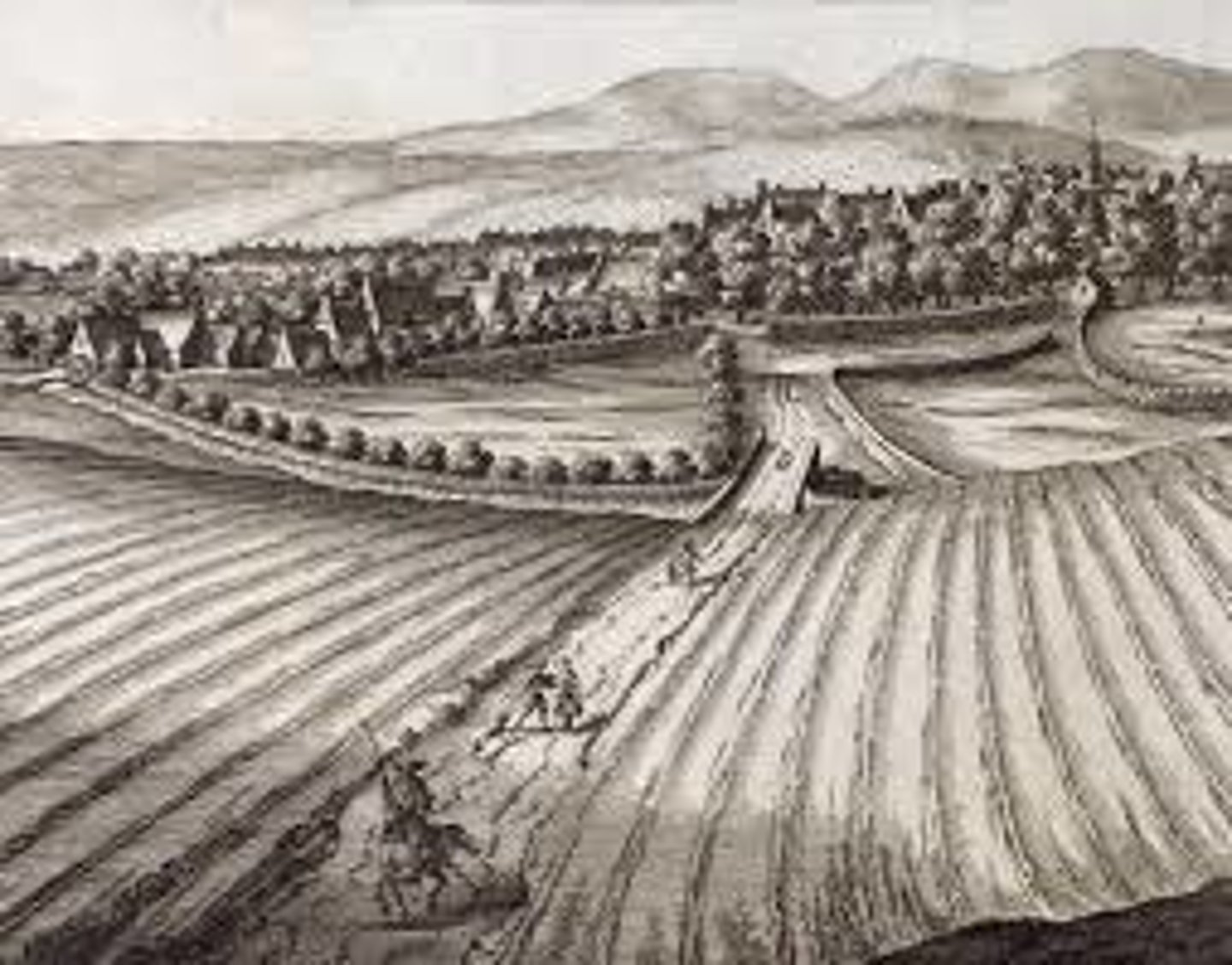
The "Three sisters" (corn, beans, and squash)
Around 9,000 years ago, about the same time human beings first began to domestic plants for food in other parts of the world, American Indians began to domesticate these three crops (among many others) which went on to form the basis of agriculture in the Western Hemisphere. This transition from hunting and gathering to settled agriculture is known as the "neolithic revolution" or "agricultural revolution." Not all Native Americans adopted agriculture, but many, such as the Aztec and Inca did.
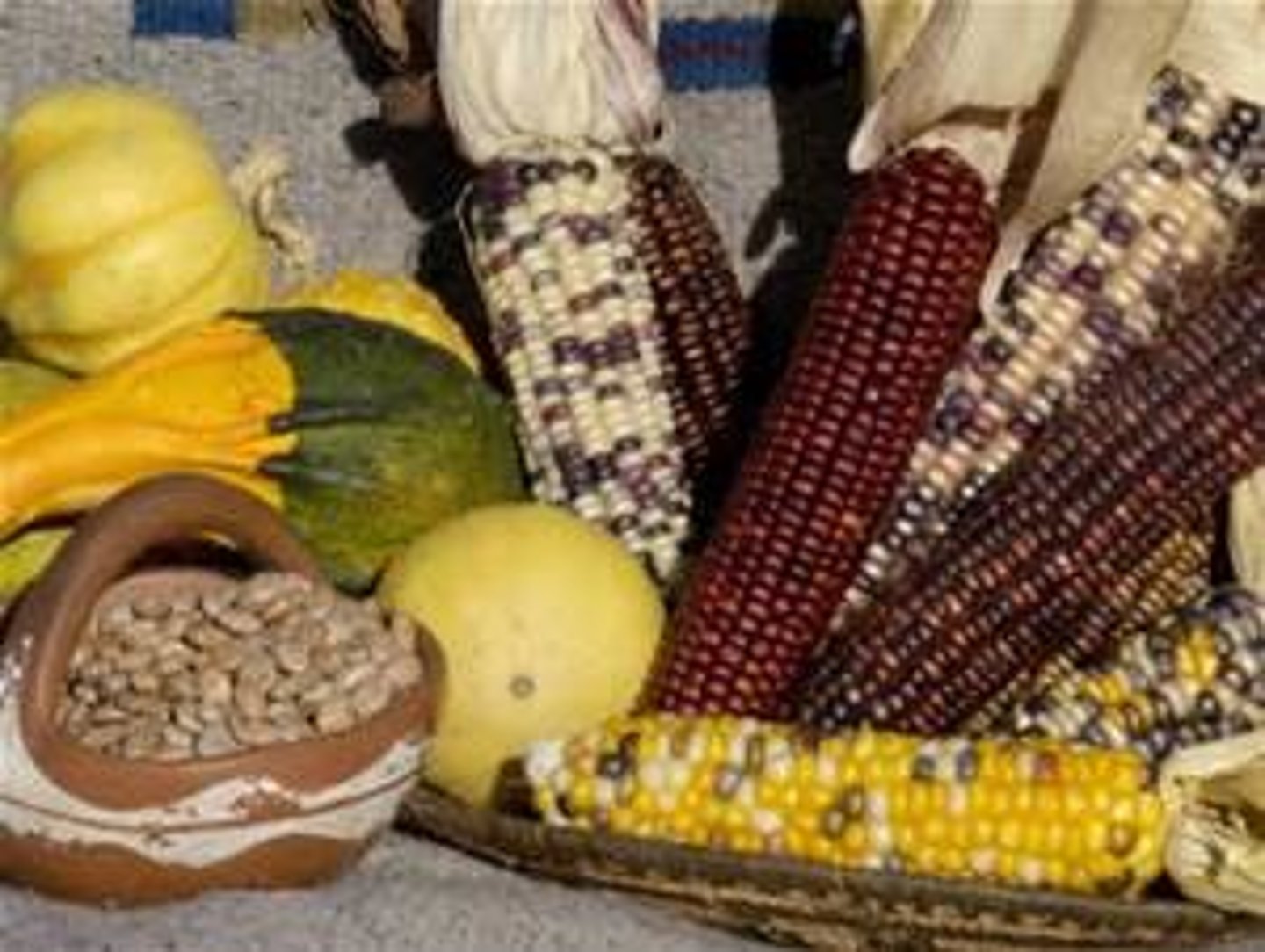
Aztecs and the capital of Tenochtitlan
This powerful Native American civilization centered in what is today Mexico, contained cities, roads, irrigation systems, extensive trade networks, and pyramid-temples that still inspire wonder. Its capital city, with a population of close to 250,000 people, was one of the world's largest cities. Much of the city and the Aztec culture was destroyed by the Spanish through disease and warfare.

Cahokia
Several hundred years before Columbus arrived in America, this was the largest city and center of Native American culture in the Mississippi River Valley of North America. With a walled/fortified city of around 12,000 people in 1200 ad, it stood as the largest settled community in what is now the United States until it was surpassed in size by Philadelphia and New York around 1800. Its remains can still be visited today. Native Americans here, and North America more generally, had not developed the scale or centralized organization of the Aztec and Inca civilizations in Central and South America. They also lacked the technologies Europeans had mastered, such as metal tools, writing, gunpowder, and the scientific knowledge necessary for long-distance travel. But they had perfected techniques of farming, hunting, and fishing, developed structures of political power and religious belief, and engaged in far-reaching networks of trade and communication.

English Liberty
The English idea that the English king was subject to the rule of law and that all free persons should enjoy the security of person and property. These rights included habeas corpus (the right not to be imprisoned without a legal charge), the right to face one's accuser, and trial by jury (rather than "trial by ordeal"), and the right not to have your property confiscated without being convicted of a crime. These rights--although very limited from the perspective of the 21st century--were actually quite expansive for the 1600s, particularly because they were beginning to be understood as the common heritage of all Englishmen, including English colonists. And from this initially limited concept of freedom, much more expansive visions of freedom and rights would evolve throughout U.S. history. This early conception of the British Empire as the world's guardian of liberty helped to legitimize English colonization. By the 1770s, many English colonists would come to view British taxation and regulations of the colonies as a threat to these freedoms, which would be one major cause of the American Revolution.
The Seventeenth Century
The 1600s (Misconception alert: When you come across a century term in your reading, it's always a good idea to translate it into years in your head. For example, if you read the term 17th century, think the 1600s.)
The Chesapeake Colonies
The English colonies of Virginia and Maryland, which grew prosperous exporting tobacco, a labor-intensive crop initially cultivated by white, mostly male, indentured servants and later by enslaved Africans. By the 18th century, the Chesapeake had developed into a "slave society" with an elaborate hierarchy of degrees of freedom. At the top stood large planters (plantation owners), below them numerous lesser planters, and landowning yeoman (small farmers), and at the bottom a large population of convicts, indentured servants, tenant farmers, and slaves. 270,000 African slaves resided in the Chesapeake in 1770, nearly half the region's population.

The New England Colonies
The northern English colonies of Massachusetts, Rhode Island, Connecticut, and New Hampshire. They were initially settled by Puritans who developed small towns with family farms, achieving a thriving mixed economy of agriculture and commerce with relatively few slaves (3% of the population in 1770).
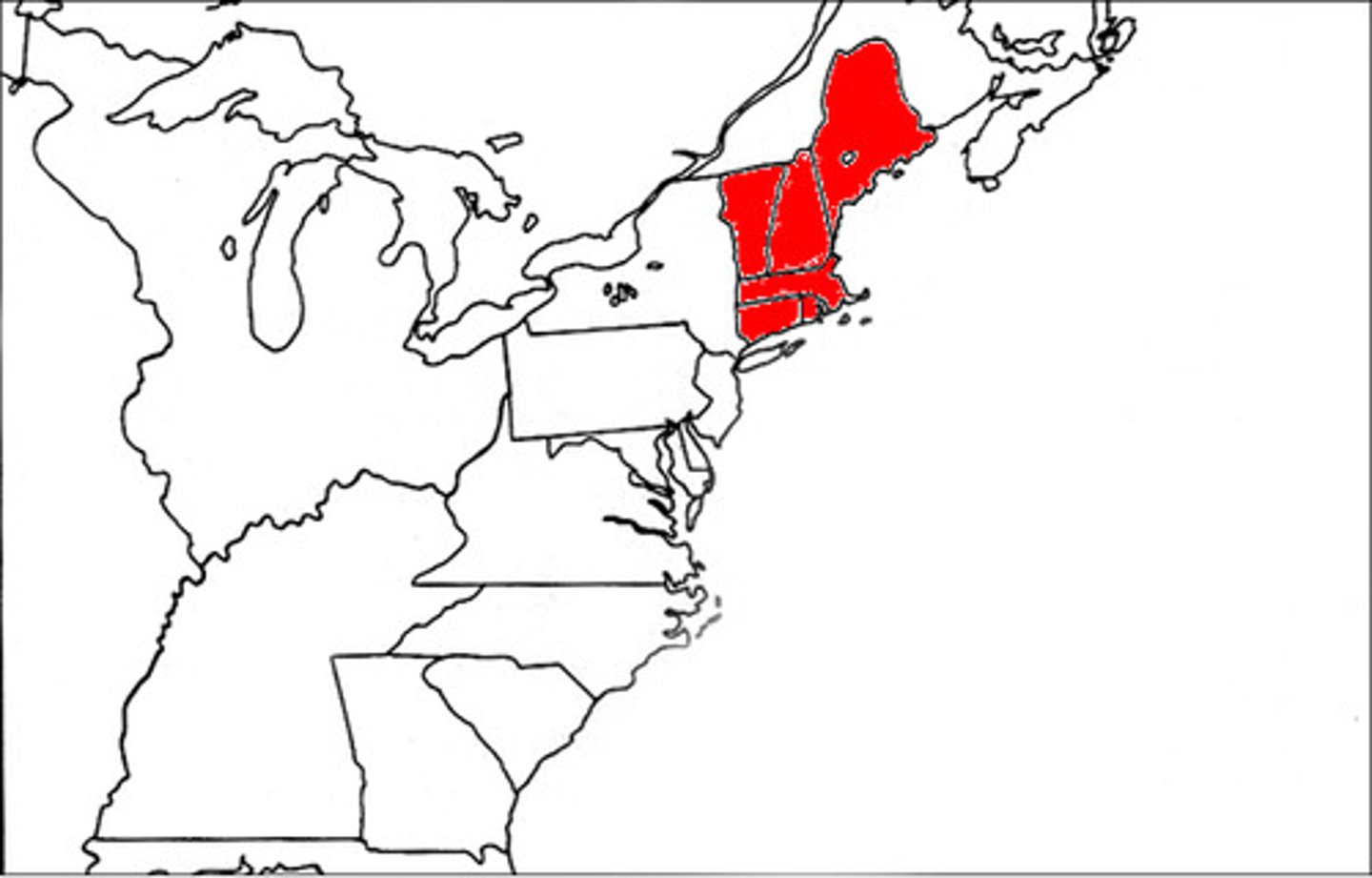
The Middle Colonies
The English colonies including New York, Pennsylvania, New Jersey, and Delaware. They supported a flourishing export economy based on cereal crops and attracted a broad range of European migrants, leading to societies with greater cultural, ethnic, and religious diversity and tolerance. Port cities in these colonies, like New York and Philadelphia, contained a significant number of enslaved Africans by the 18th century.
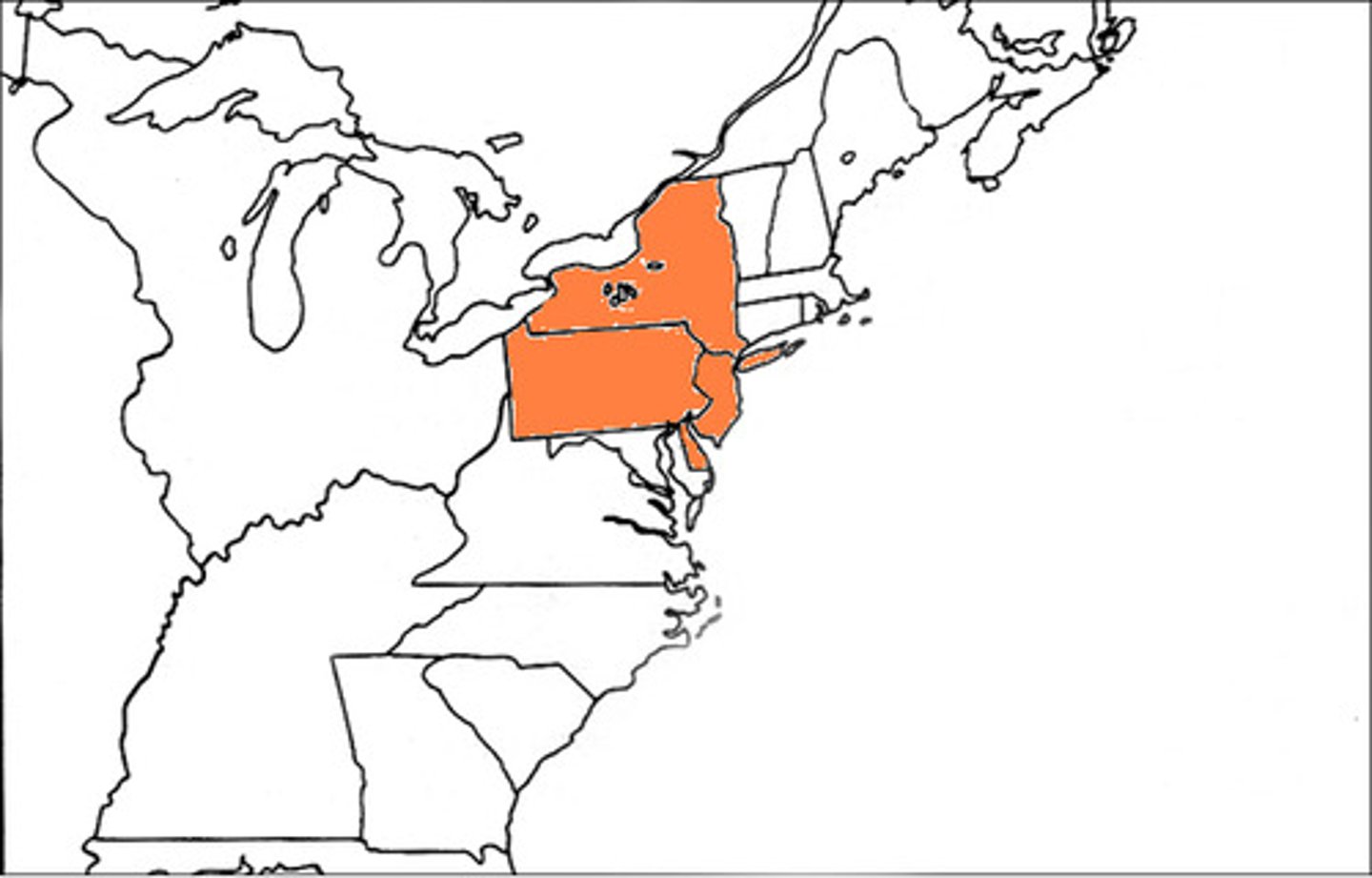
The Southernmost Colonies
The English colonies of Georgia, the Carolinas, and the British West Indies. These used their long growing seasons to develop plantation economies based on exporting staple crops like rice and indigo on the mainland, and sugar in the West Indies. They depended on the labor of enslaved Africans, who often constituted the majority of the population in these areas and who developed their own forms of cultural and religious autonomy.
The Anglican Church
The established Protestant Church of England (and several English colonies in the Americas) during the Colonial Era. After the Pope (the official head of the Roman Catholic Church) refused to allow England's King Henry VIII to divorce his wife, King Henry severed England's ties with the Catholic Church and instead created this church as the established church of England. This event is called "the English Reformation," which was just one part of the larger "Protestant Reformation" begun by Martin Luther a decade earlier, and it launched England into over a century of religious conflict and war as Catholics, Anglicans, and other new Protestant religious sects of Christianity (including the Puritans) struggled for control of England.
coverture
The legal doctrine in early modern England and its colonies in which a woman's legal identity was subsumed under that of her husband when she married. Due to this doctrine, a married woman could not own property, sign contracts, control her wages if she worked outside the home, or write a separate will. The husband conducted business and legal matters on behalf of the entire family. This form of male dominance and female submission reflected how early modern European societies were extremely hierarchical, contrasting with most Native American societies.
Jamestown (1607)
Established in 1607, this was the center of the Virginia Colony and the first permanent British colony in North America. For this reason, 1607 is often used to mark the start of the British "Colonial Era" in North America.
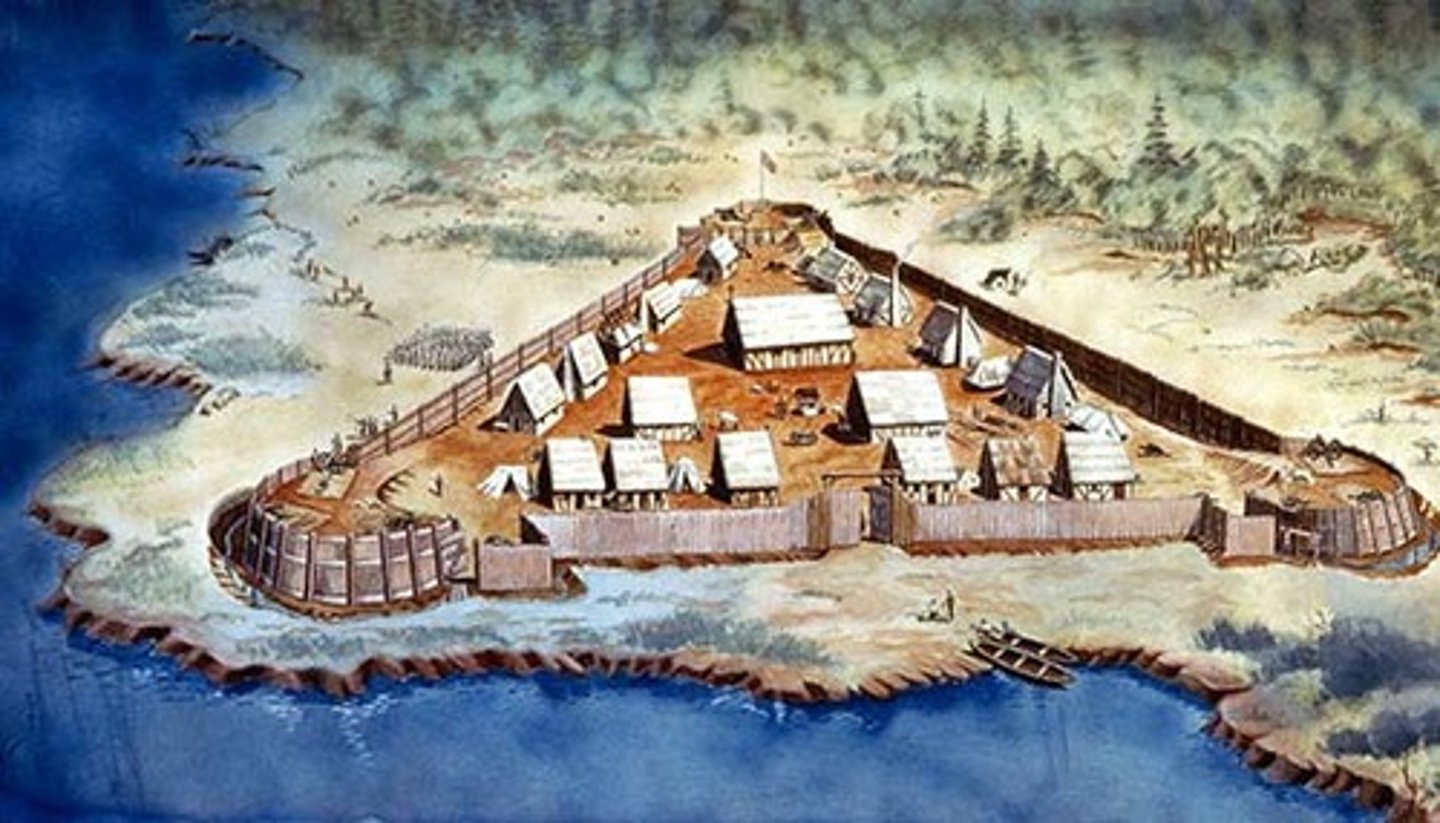
Tobacco Colony
A colony in which growing tobacco was the main source of profit; tobacco farming in Virginia resulted in a growing demand for field labor and a distinct class hierarchy. Virginia became a dispersed community with little social unity, working mainly towards profit.
The Anglo-Powhattan Wars (1610-1646)
A series of violent conflicts in the Chesapeake Bay region between 1610 and 1646 over land and resources between a Native American confederacy and the English colonists of Jamestown. The wars included horrible massacres and massive destruction on both sides. By 1646, the outnumbered Indians submitted to a treaty that acknowledged their subordination to Jamestown and required them to move to reservations.
The Virginia Company
The private business that founded the first permanent British colony in the Americas, Jamestown. It was a "joint-stock company," which was a business entity in which shares of the company's stock could be bought and sold by shareholders. In this way, private English investors pooled their money to finance a colonial settlement in hopes of turning a profit. Joint-stock companies like this one were an early institutional step in the development of modern capitalism.
Headright System (1618)
A policy first announced by the Virginia Company in 1618, by which the company granted 50 acres of land to any colonist who paid for his own or another's passage to Virginia. Given the extraordinarily high death rate in Virginia in the first few decades of colonization, this policy was necessary in order to attract a steady supply of new settlers. It also resulted in an extremely stratified class society with a small number of wealthy land-owning planters at the top that composed Virginia's social and political elite along with a large number of landless indentured servants and, later, enslaved Africans.
The House of Burgesses (1618)
As the first elected assembly in colonial America, it was established in 1618 by the Virginia Company and first convened in 1619; only landowners had voting rights and the company retained the right to nullify any measure adopted. This legislative body established the precedent of self-government in the British Colonies, which would grow and eventually lead to the shift from monarchy to republicanism/popular sovereignty during the American Revolution.
Indentured Servant
A settler who signed on for a temporary period of servitude (usually five to seven years) to a master in exchange for passage to the New World and "freedom dues," which often included some money and/or land (if one survived his/her term of service despite the high death rate). Nearly two thirds of all English settlers in North America arrived as these.
Bacon's Rebellion (1676)
This unsuccessful 1676 revolt was led by planter Nathaniel Bacon against the Virginia governor William Berkeley and his administration because of governmental corruption and because Berkeley had failed to protect settlers from Indian raids and did not allow the settlers to occupy Indian lands. This failed revolt caused the surviving Virginia elite to move away from indentured servants (because they did not want another rebellion) and towards a different labor supply that would never gain freedom and demand land on the frontier: enslaved Africans.
The Virginia Slave Code of 1705
Enacted by the House of Burgesses in Virginia, the code categorized slaves as property that could be bought and sold, fought over in court, and inherited. Nearly a century after the founding of Jamestown in 1607, this code illustrates how slavery evolved gradually in the colonies. As chattel slavery became the dominant labor system in many southern colonies, new laws like this created a strict racial system that prohibited interracial relationships and defined the descendants of African American mothers as black and enslaved in perpetuity
African American identity
An identity that emerged among enslaved people in the British mainland colonies by the end of the 18th century from the common experience of being enslaved and the common desire for freedom. The nearly 300,000 Africans brought to the English mainland colonies in the 1700s came from different parts of Africa, sustained different cultures, spoke different languages, practiced different religions, and would otherwise have never encountered one another or considered their color or residence on the continent of Africa as a common source of identity. However, by the 19th century, after being thrown together in bondage, enslaved Africans no longer identified as Ibo, Ashanti, Yoruba, and so on. In music, folklore, language, and religion, their cultural expressions emerged as a synthesis of African traditions, European elements, and new conditions in America.
Anthony Johnson
An African who arrived in the Virginia colony as an indentured servant in the mid-1600s, became free, and eventually owned land and slaves himself. This person illustrates how race was still a fluid social construct in the 17th century, and one's race had not yet come to determine whether one would be free or enslaved.
Femme Sole
Meaning "a woman alone," this was special legal status available in the Virginia colony to widows and the few women who never married. This legal status (denied to married women) enabled them to make contracts and conduct business, opportunities women rarely assumed in Europe.
The Act Concerning Religion (The Maryland Toleration Act) (1649)
A 1649 act institutionalized religious toleration in the colony of Maryland (part of the "Maryland Experiment") by allowing all Christians (both Protestants and Catholics) to freely exercise their religion. This was an early example of religious tolerance, a principle that would later become an important tenant of the philosophy of liberalism.
The "Holy Experiment" of Pennsylvania
William Penn, a proprietor, established the colony of Pennsylvania in the late 17th century and envisioned it as a place where those facing religious persecution in Europe (particularly the Quakers) could enjoy spiritual freedom and colonists and Native Americans could exist in harmony. As in Maryland, was another early example of religious tolerance, a principle that would later become an important tenant of the philosophy of liberalism.
Quakers ("Society of Friends")
A dissenting religious group, many of whose members settled in Pennsylvania because it offered them freedom from religious persecution elsewhere, that believed the spirit of God dwelled within every individual (not just "the elect," as the Puritans believed), and that this "inner light," rather than the Bible or teachings of the clergy, offered the surest guidance in spiritual matters. They were one of the many new Protestant sects of Christianity founded the social upheaval of the English Civil War of the 1640s , and they were early proponents of the abolition of slavery and equal rights for women.
Dissenters
European Protestants who belonged to any religious denomination other than the established church in their native country (or colony). They were frequently persecuted, often violently. (An "established church" is one that receives government funds raised by taxes on the population.)
Puritans (1630)
A dissenting Protestant religious group from England that sought to purify the Anglican Church of England because they believed it retained too many elements of Catholicism and was not "pure" enough. They rejected Catholicism's top-down religious authority descending from the Pope and instead insisted that only independent local congregations should choose clergymen and determine modes of worship. Thus they were also called "Congregationalists." They founded Plymouth Plantation in 1620, the Massachusetts Bay Colony under John Winthrop in 1630, and dominated the New England colonies for much of the 17th century. They urged believers to read the Bible and listen to sermons (and thus Puritan communities had some of the highest rates of literacy and education in the world). They also believed in "predestination," the idea that God had divided people into two groups "the elect" (who were saved and would go to Heaven) and the damned" (who would go to Hell), and nothing anyone did would make any difference. Nevertheless, the believed worldly success--leading a good life, and prospering economically--were likely signs of the elect, while idleness and immoral behavior were interpreted as signed of damnation. These beliefs fueled a culture of hard work that would later be known as "the Puritan work ethic."
Pilgrims (1620)
Puritan Separatists who broke completely with the Church of England, first fled to the Netherlands, then sailed to the New World aboard the Mayflower, becoming the first Puritans to immigrate to the New World, founding Plymouth Colony on Cape Cod in 1620.
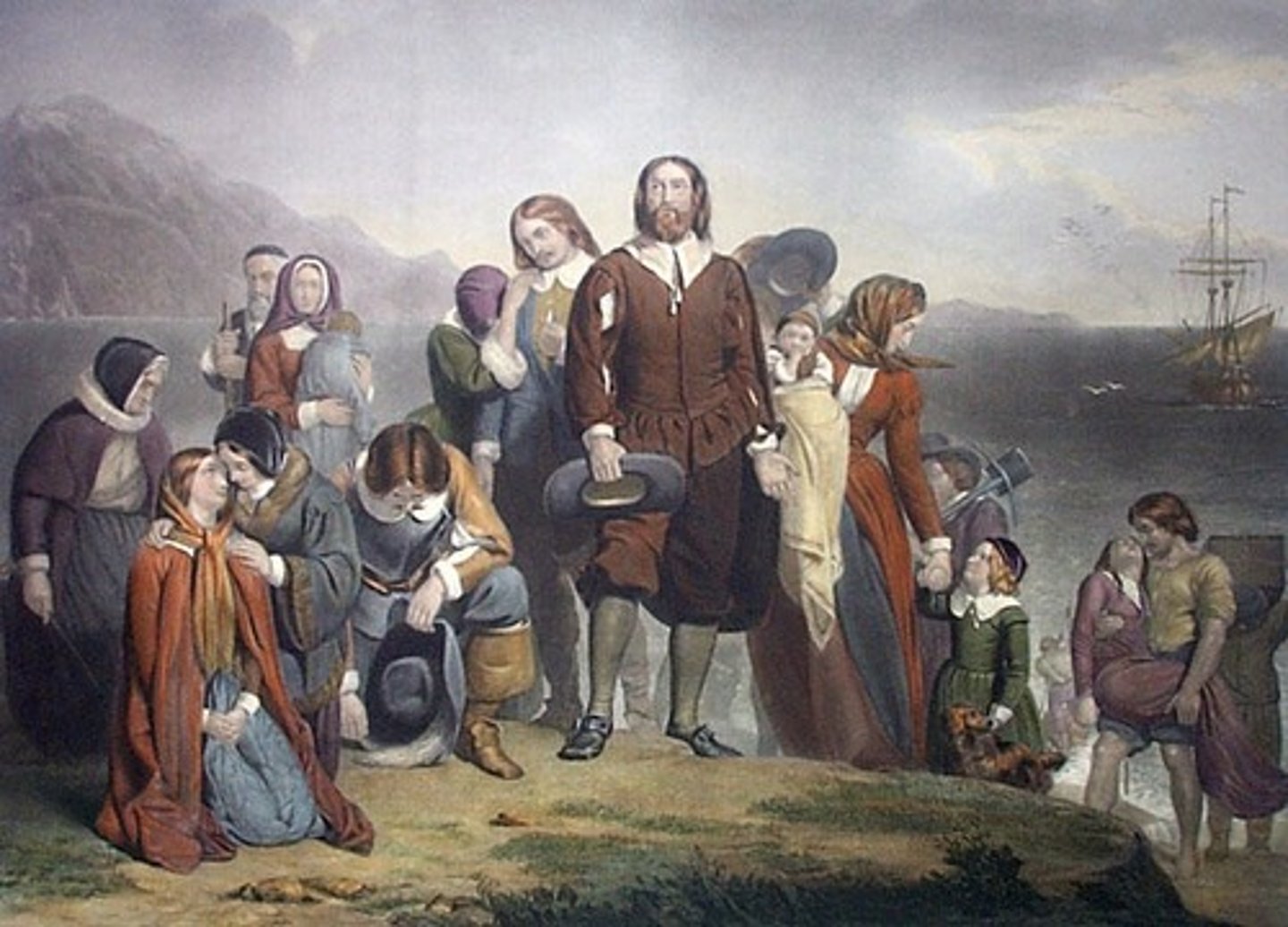
The Great Migration (1629-1642)
Period between 1629 and 1642 in which a great number of Puritans (about 21,000) migrated from England to Massachusetts.
John Winthrop
The first governor of the Massachusetts Bay Colony, a Puritan, who distinguished between "natural liberty" (liberty to do whatever you feel like doing, including evil) and "moral liberty" (liberty to do good, as defined by the Bible), and believed that true freedom required the subjection to authority and to God's will. He is illustrative of the Puritans' quest for religious freedom in the new world, a quest that was compatible with severe restraints on speech, religion, and personal behavior. (Notice, the philosophy of liberalism was not present at the founding British colonies.)
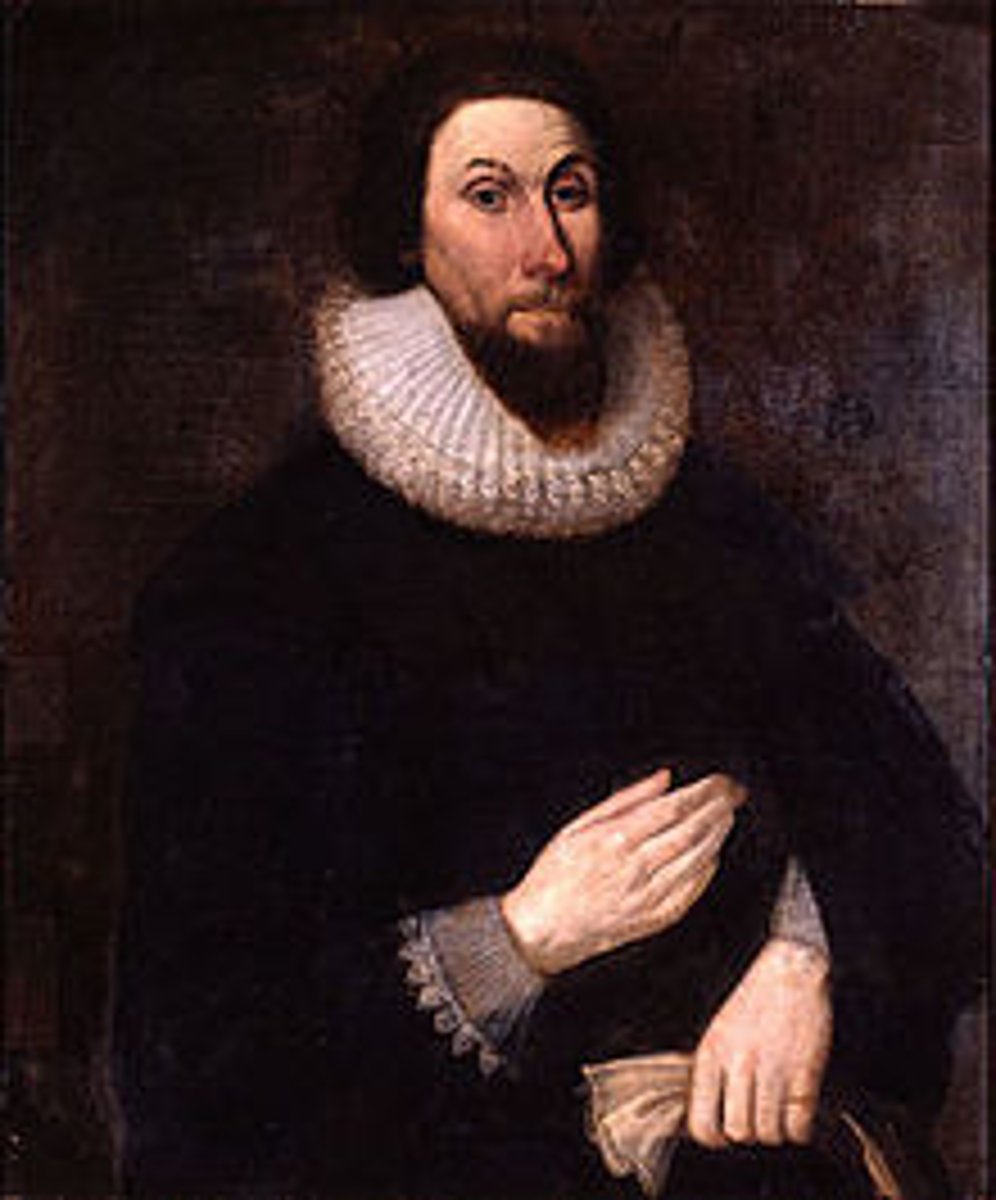
Moral Liberty
The Puritan idea of "liberty to that only which is good"; or to be liberated from one's self-destructive tendencies. This form of liberty could entail restraints on speech, religion, and personal behavior, and it understood liberty as a spiritual state where people had the opportunity and responsibility to obey God's will and subject themselves to his authority.
The Mayflower Compact (1620)
Before they landed at Plymouth in 1620, the forty-one adult men aboard the Mayflower signed this document in which they agreed to obey "just and equal laws" enacted by representatives of their own choosing. This was the first written frame of government in what is now the United States. Men not normally signatories to such documents--printers, carpenters, even indentured servants--were among those to affix their names. This was over 200 years before most working-class men were allowed to vote in Great Britain.
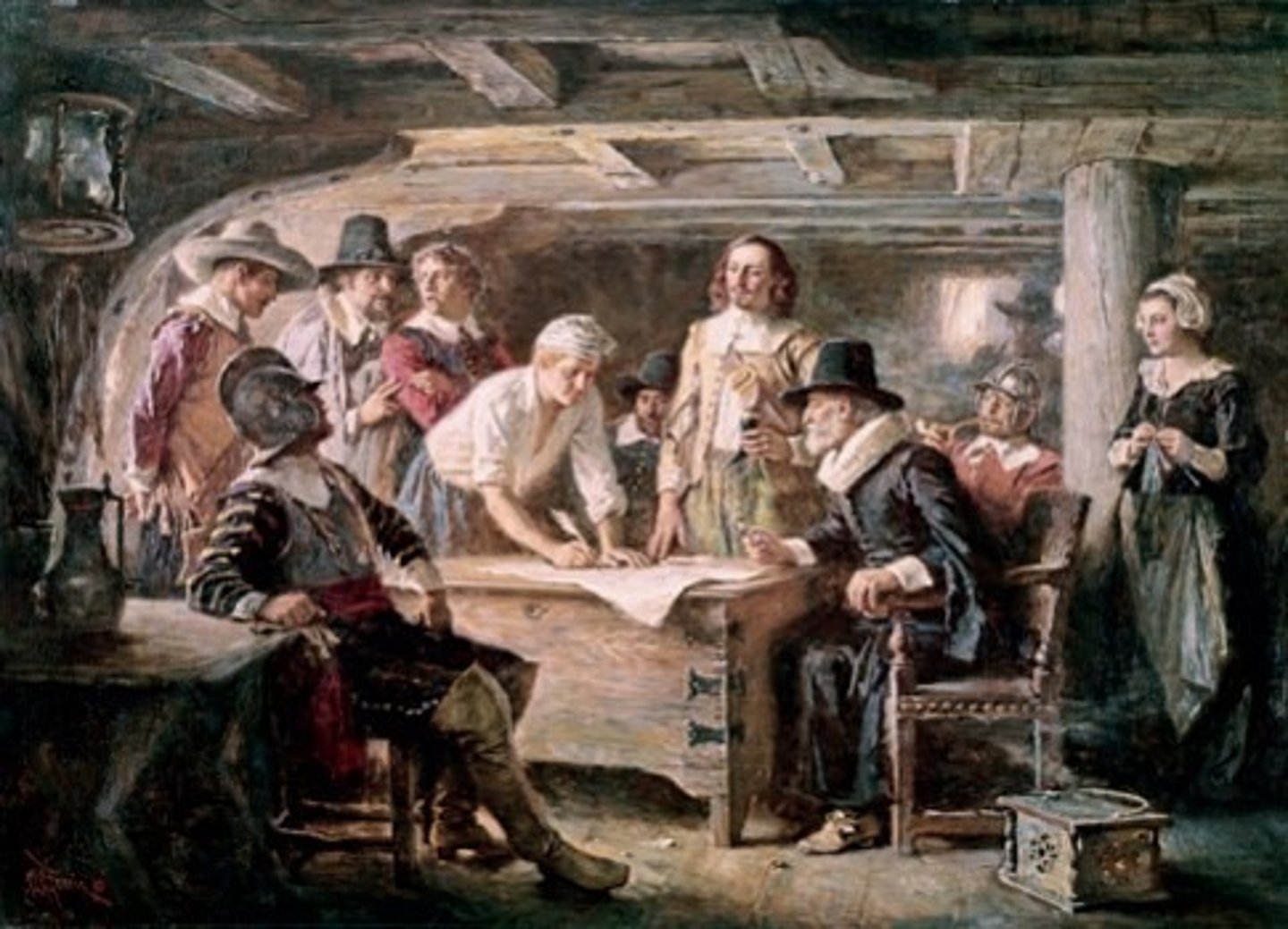
Religious and Property Qualifications
While a far higher percentage of the population could vote in the English colonies compared to the England homeland, voting restrictions varied from colony to colony and generally took two forms. Most colonies required voters to possess a specified amount of property (usually land) to cast a ballot. The purpose was to ensure that voters possessed "a stake in society" and the independence of judgment that supposedly went with it. Slaves, indentured servants, the poor, and women lacked property and were thus ineligible to vote. By contrast, voting in Massachusetts required being a member of the Congregationalist (Puritan) Church. While these two sets of qualifications restricted who could vote, they represented a vast expansion in political freedom and the right to vote compared to England in the 17th century. Both sets of qualifications would be eliminated in the first half of the 19th century. Notice: the principle of "popular sovereignty"--the idea that governments deriving their just power and authority from the consent of the governed--is only beginning to emerge an important principle in the Colonial Era.
The "City Set Upon a Hill"
When the Puritans immigrated to New England, they hoped to escape what they believed to be the religious and worldly corruptions of English society. This famous phrase, a biblical reference from John Winthrop, implied the Puritans' intention to establish a biblical commonwealth whose influence would flow back across the Atlantic to rescue England from godlessness and social decay. It's an early articulation of the concept of "American Exceptionalism."
Roger Williams
New England's most prominent advocate of religious toleration, he was a Puritan minister who insisted that church and state should be separated and that individuals be allowed to follow their consciences and practice whatever form of religion they choose. Banished from Massachusetts in 1636, he and his followers moved south and established the colony of Rhode Island, which became a beacon of religious freedom. Rhode Island had no established church, no religious qualifications for voting until the eighteenth century, and no requirement that citizens attend church. It became a haven for religious dissenters and Jews persecuted in other colonies.
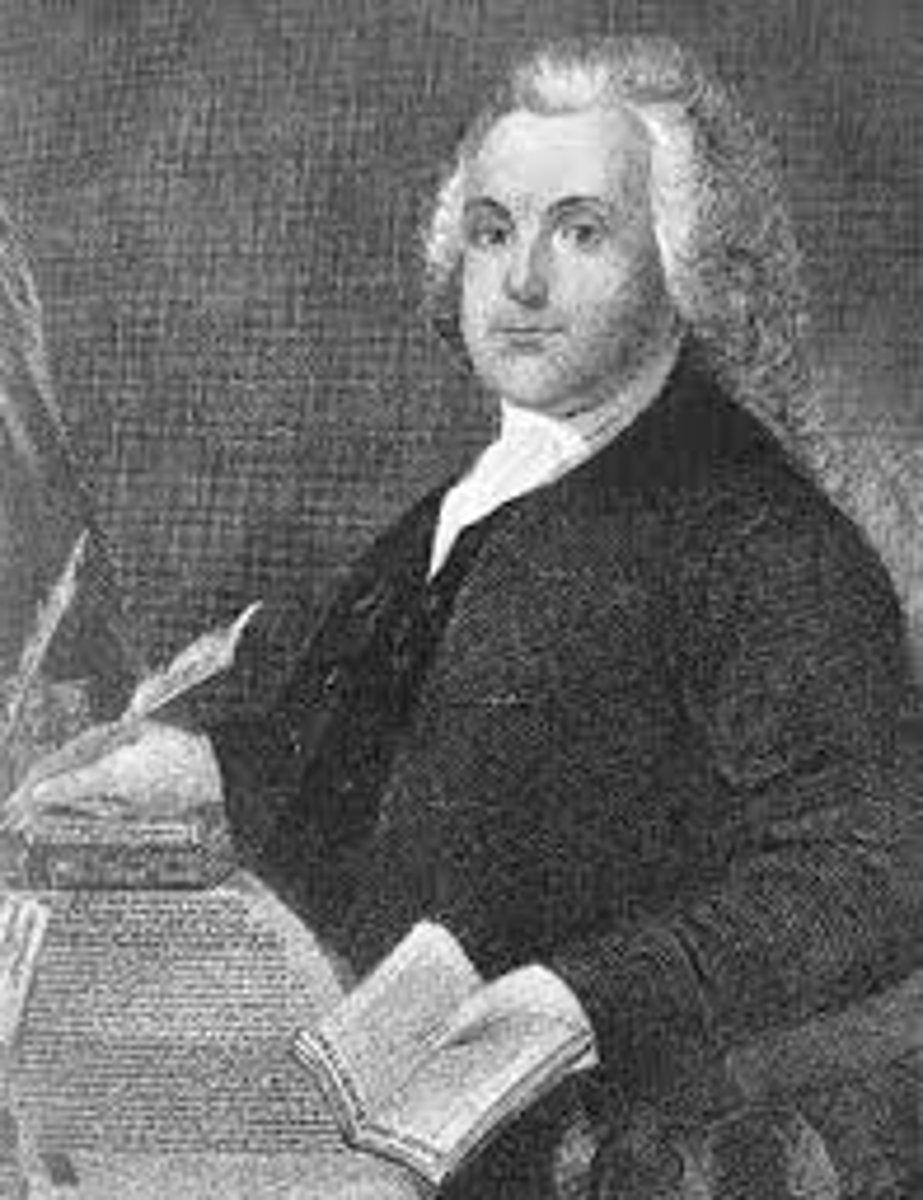
Anne Hutchinson
Puritan woman who in the 1630s attracted a large and influential following for challenging the views of the Puritan ministers who claimed they could distinguish "saints" form the damned on the basis of activities such as church attendance and moral behavior rather than an inner state of grace. She was put on trial for sedition and banished from the colony. Her story illustrates the limits of Puritan religious toleration and gender equality.
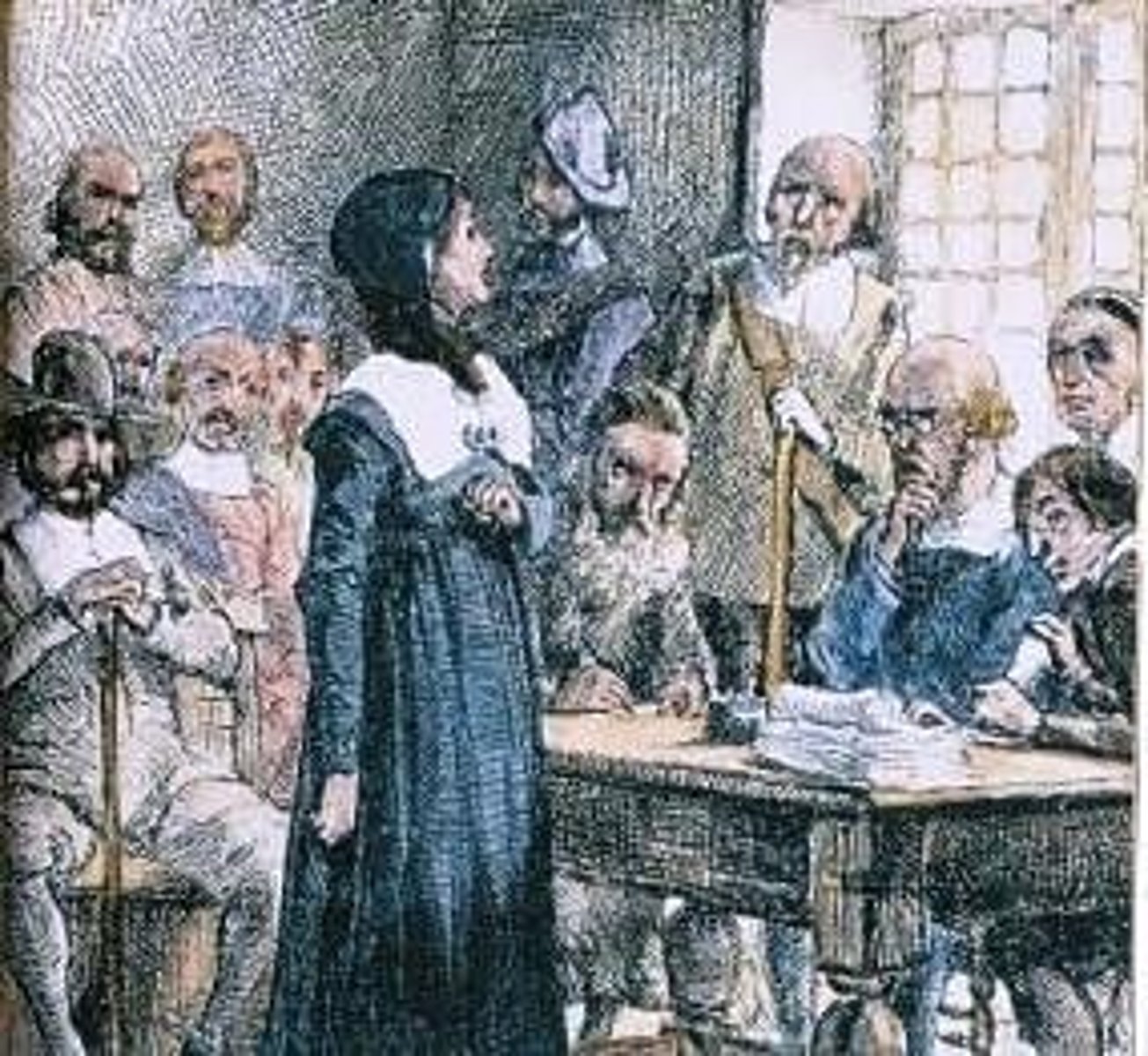
The Pequot War (1637)
An armed conflict in 1637 that led to the destruction of one of New England's most powerful Indian groups. In this conflict over land and resources, the English settlers of Massachusetts Bay allied with Mohegan and Narragansett Indian allies to wage war against the nearby Pequot Indians (who had forced the Mohegan and Narragansett Indians to pay them tribute). By the end, most Pequot Indians had been killed, sold into slavery, or absorbed into other Native communities.
The Mystic River Massacre
When an English fur trader was killed by Pequot Indiains, a group of Connecticut and Massachusetts colonizers joined by Narragansett Indian allies raided the main Pequot village and killed over 500 indians (men, women, and children); after the end of the war months later, the majority of the Pequots were dead or sold into slavery (Many historians consider this an early example of "genocide").
The New England Economy
Far more diverse than the Southern plantation economy, this regions economy was composed of small farming, merchants, artisans, harvesting lumber, shipbuilding, fishing, and shipping.

Half-Way Covenant (1662)
This was an attempt to address the growing commercialization of Puritan society reflected in the lack of a younger generation involved in the established church. Rather than requiring people to testify about their conversion experience publicly as the founding generation of Puritans had, now the church created a halfway membership for all grandchildren of immigrants during the Great Migration; this made it easier for the younger generation to engage in the Church, and it made the Church more relevant in an increasingly business-oriented culture. Because hard work and commercial success had always been central to Puritan values, the commercialization of New England was as much a fulfillment of the Puritan mission in America as a betrayal.
Artisans
Skilled workers and masters of a specific craft--such as carpenters, masons, shipwrights, butchers, blacksmiths, tailors, and shoemakers--who were socially distinct from common laborers in the Colonial Era. Their skills gave them far more economic freedom than those dependent on others for a livelihood, and they profited from the expanding consumer market in the colonies. A young unskilled man would often be apprenticed out to work for years under a skilled artisan who would gradually teach him the skills of the trade so that one day he might become an artisan himself. As the Industrial Revolution picked up speed later in the 19th century, many of these artisanal professions were mechanized and replaced by unskilled laborers.
King Phillip's War (1675-76)
Began in 1675 when a Native alliance, led by the Wampanoag Indians, launched attacks on New Englanders whose farms were encroaching on its lands, this was the most violent warfare in the region in the 17th century. Indians attacked nearly half of New England's 90 towns, destroying many, and driving the colonists almost all the way back to the Atlantic coast. But the tide of war turned when Mohawk Indians joined the fight against the Wampanoags, and together colonial and Native forces inflicted devastating punishment. The end result was broadened freedoms for white New Englanders by expanding their access to land and dispossessing most of the region's native people.
The Salem Witch Trials (1692)
A crisis of trials and executions in Salem, Massachusetts in 1692 that resulted from anxiety over witchcraft. Since the only way of avoiding persecution was to confess and name others, accusations of witchcraft began to snowball, and hundreds of residents of Salem came forward to accuse their neighbors. Fourteen women and five men were hanged. In the end, it was clear that something was seriously wrong with the colony's system of justice. Magic, astrology, and witchcraft had been widespread in 17th century America and Europe, but the events in Salem discredited the tradition of prosecuting witches and encouraged prominent colonists to seek scientific explanations for natural events such as comets and illnesses (contributing to the intellectual movement known as the Enlightenment), rather than attributing them to magic.
The Eighteenth Century
The 1700s (Misconception alert: When you come across a century term in your reading, it's always a good idea to translate it into years in your head. For example, if you read the term 18th century, think the 1700s.)
The German Migration
The largest group of immigrants to the British colonies from the mainland European continent. In the 1700s. Their sending country was not yet a single nation; it was divided into numerous small states, each with its own official religion. Dissenters from these official religions were often persecuted, and combined with the difficulty acquiring land, many of them decided to migrate to America. In the 1700s, probably the most striking thing about colonial American society was its sheer diversity. Africans, Irish, Germans, Welsh, Scotts, English, and others composed a British colonial population that grew nearly tenfold, from 265,000 in 1700, to over 2.3 million by 1770!
Salutary Neglect
The British government's policy of leaving the colonies to largely govern themselves during the first half of the eighteenth century. This benign neglect by "the crown" enabled a relatively high degree of political self-government ("popular sovereignty") to establish itself; American elites and the assemblies they dominated became more and more assertive and insisted that they possessed the same rights and powers in their colonial affairs as the House of Commons enjoyed in Britain. This desire for self-government will culminate in the American Revolution in the late 1700s.
Mercantilism
The dominant economic theory of the Colonial Era which said governments should regulate economic activity to promote national power. According to this economic theory, governments should encourage domestic manufacturing and control trade so that exports, which generated revenue from abroad, exceed imports, which require paying foreigners for their products. Under this theory, the purpose of colonies was to serve the economic interests of the mother country; therefore England tightly controlled the trade of its colonies (but the colonies still engaged in frequent illegal smuggling). This economic theory was replaced gradually by the growing dominance of the theory of free-market capitalism (advanced by Adam Smith's The Wealth of Nations) in the 19th and 20th centuries. Notice: market-based economies (with little government regulation), central to the philosophy of liberalism, were not yet established during the Colonial Era.

The Navigation Acts (1650-1775)
The English Parliament passed these economic regulations to control and restrict colonial trade and bolster the mercantile system, 1650-1775; All major colonial exports, such as tobacco and sugar, had to be shipped on English ships and pass through Britain before being shipped to mainland Europe, thus ensuring England would profit most from the transport and taxation of these products. Enforcement of the acts led to growing resentment by colonists by the Revolutionary Era.
The Triangular Trades
The Atlantic trade system that operated for over several centuries (during the 1500s, 1600, and 1700s) carrying cash crops and raw materials from the Americas to Western Europe where they were exchanged for manufactured goods that were shipped to West Africa where they were traded for human beings that would be sold into slavery and shipped to the Americas.

The Atlantic Slave Trades
The systematic importation of African slaves from their native continent across the Atlantic Ocean to the New World, largely fueled by rising demand for sugar, rice, coffee, and tobacco. Historians estimate that between 1500-1900, about 12 million Africans were kidnapped by African empires on the West Coast of Africa, sold to European traders on the coast, and then shipped to the Americas s, making it the largest forced human migration in human history. By the late 18th and early 19th century, an abolitionist movement developed that condemned the trade as a crime against humanity. The United States finally prohibited the importation of slaves in 1808, but slavery itself was not abolished until the Civil War in the 1860s.
The Middle Passage
This term refers to the terrifying journey endured by millions of enslaved Africans who were shipped across the Atlantic ocean during the Colonial Era; such voyages had a high death rate and were particularly gruesome and harrowing for the Africans, who were usually shackled and packed like cargo below deck. Most victims were captured by West or Central African slave traders who then sold them to European slave traders on the Atlantic coast of Africa. The vast majority were shipped to Brazil and the West Indies, and only a small percentage (5%) were taken to the British colonies in North America.
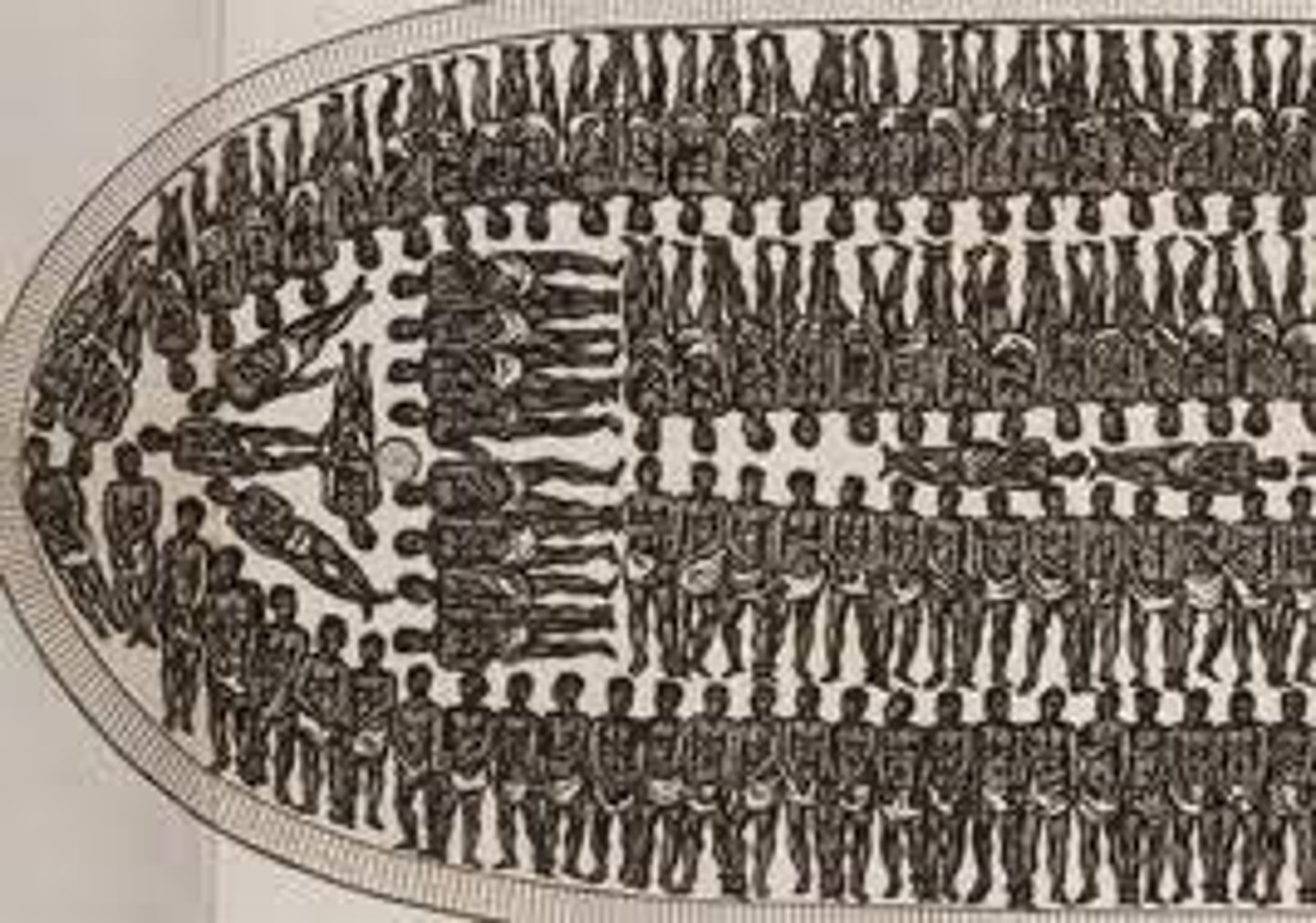
The Uniqueness of American Slavery
Slavery did not begin in the Americas; slavery dates back thousands of years throughout the entire span of human civilization, and slavery had been central to almost every major civilizations and empire around the world. People of all races have practiced slavery, and people of every race have been enslaved themselves throughout history. However, the style of plantation slavery that developed in the Americas during the 16th through 19th centuries was particularly brutal. It was largely based on plantations, and therefore the imbalance between a small number of overseers and the large enslaved population made it necessary to police the system with extreme violence. Plantation slavery was also more demanding, involved a higher death rate, and by the 18th century, it would come to be associated with race.
The Stono Rebellion (1739)
A slave uprising in 1739 in South Carolina in which a group of slaves, recently arrived from Kongo, seized a store containing weapons, and marched southward, beating drums to attract followers, killing twenty whites and shouting "liberty." The uprising was put down, and in its aftermath, the slave code was severely tightened. This was the largest slave rebellion in the 18th century and one of countless acts of African resistance to slavery.
Freedom of Speech
Originating in Britain during the sixteenth century, the phrase referred only to the ability of members of Parliament to express their views without fear of punishment, on the grounds that only in this way could they effectively represent the people. Outside Parliament, this freedom still had no legal protection in the 1700s and was not yet considered part of the "rights of Englishmen." However, by the 19th century, this freedom would become a central tenant of the philosophy liberalism and a core ideal of the U.S. and other liberal societies around the world.
The public sphere
This term refers to the area in social life where individuals come together to freely discuss and debate societal problems in order to take political action. Traditionally dominated by the educated elite and taking place in newspapers, pamphlets, letters, and speeches, these areas expanded considerably with the 18th-century Enlightenment to include many ordinary citizens taking part in literary, philosophical, and scientific clubs. Colonial taverns and coffeehouses also became important sites for political debate. The American Revolution would dramatically expand this arena, and today it is a central component of all liberal societies (and the enemy of all dictators and totalitarian regimes).
Freedom of the press
Today in the U.S., communication and expression in various media is a right to be freely exercised, but in the 1700s, this freedom was unknown around the world and regarded as dangerous by all governments. In colonial America, this freedom was most frequently discouraged by elected assemblies, while early newspapers began to defend it as a central component to liberty. The American Revolution would dramatically expand this freedom, and today it is a central component of all liberal societies (and the enemy of all dictators and totalitarian regimes).
The Trial of John Peter Zenger (1734)
A German American printer and journalist in New York City who printed opinions critical of the colonial governor. He was accused of libel in 1734 by the governor of New York, but the jury acquitted him, and he therefor became an early symbol for freedom of the press in the British colonies. This trial reflects how the ideas of the right to freedoms of speech and of press were not yet established and were only beginning to emerge in the Colonial Era.
The American Enlightenment
A philosophical revolution in thought in the eighteenth century that emphasized reason and science over traditional religion and gave birth to the philosophy of liberalism. This was an American extension of the same European philosophical movement that originated in France, which sought to apply the scientific method of careful investigation based on research and experiment to better understand political and social affairs. This philosophical revolution insisted that every human institution, authority, and tradition be evaluated based on reason rather than conformity to traditional religious faith.
Pluralism
Another core tenant of the philosophy of liberalism, this term refers to any system in which members of multiple minority groups are permitted to maintain independent cultures. Probably the most striking characteristic of the British colonies in the 18th century was its ethnic and religious diversity. Free and unfree newcomers arrived in the 18th century from Africa, Ireland, Germany, England, Wales, Scotland, France, Sweden, and the Netherlands. And while most colonies still retained one established (Anglican or Puritan) church, and most barred Catholics and Jews from voting and holding public office, by the mid-18th century dissenting Protestants--including Quakers, Methodists, Baptists, Presbyterians, and others--had gained the right to worship as they pleased. The presence of so many different European ethnic and religious groups contributed to a significant degree of diversity and intellectual exchange, which were later enhanced by the first Great Awakening and the spread of European Enlightenment ideas. To this day, the United States continues to be one of the most diverse societies ever assembled in human history.
Deism
The emerging 17th and 18th-century belief that God created the universe long ago but then stopped intervening in it, just as a watchmaker makes a watch and then sets it down to let it run on its own. This view differed from the widely held Christian assumption that God was at work in every event, and it reflected the emergence of Enlightenment thought in the 17th and 18th centuries that applied reason and science to understand the world as opposed to traditional faith in ancient or religious explanations.
Popular Sovereignty
The principle that a government is created and sustained by the consent of its people, who are the source of all political legitimacy. This principle emerged during the Enlightenment as a rejection of the Divine Right of Kings, and it became a core principle of the philosophies of Republicanism an Liberalism during the 18th centuries. Benjamin Franklin expressed this concept when he wrote that "In free governments, the rulers are the servants and the people their superiors and sovereigns."
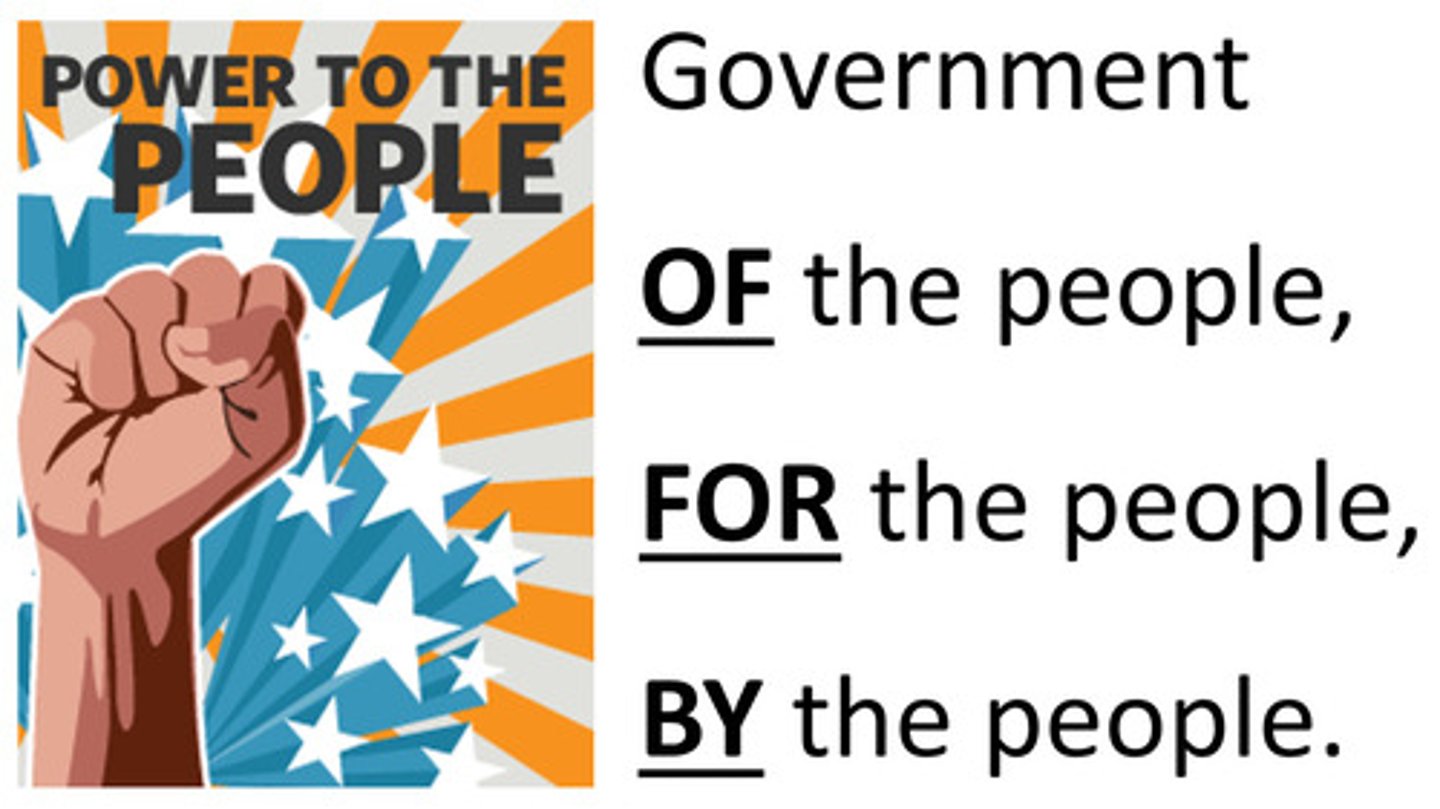
Republicanism
The new political theory in England and America in the 1700s, emerging from the Enlightenment, that challenged traditional systems of aristocracy and monarchy and instead promoted governing a nation as a republic, run by representatives of the people, which would protect the rights, liberties, and property of the people, especially by incorporating a rule of law that the government could not arbitrarily ignore. This political theory assumed that public officeholders needed to be property-owning, economically independent citizens who possessed the "virtue"--which they defined not simply as a personal moral quality but also as the capacity to exercise independent judgment and the willingness to subordinate self-interest in the pursuit of the public good.
Liberalism (Classical Liberalism)
A political and moral philosophy that emphasizes individual rights and freedoms, equality, democracy, the rule of law, markets, and secularism. Rooted in the 17th and 18th century Enlightenment period, inspiring the American and French Revolutions, this has served as the dominant philosophy throughout U.S. history. Some key aspects of it are: individual rights and freedoms, including freedom of speech, religion, and the press; equality before the law and equal opportunities for all individuals; democratic forms of government where power is derived from the consent of the governed (aka "popular sovereignty") and where citizens have the right to participate in political processes; reliance on the rule of law which is applied equally to all individuals and the government itself; a market-based economy with some degree of regulation to ensure social welfare; and the separation of church and state to ensure that government policies are based on reason and evidence rather than religious beliefs alone.
This philosophy has evolved over the centuries into many different strands including "classical _____" (emerging in the 17th century), which emphasizes limited government and free markets, and "modern ___" (emerging in the 1930s), which supports a more active role for the government in promoting social and economic well-being.
John Locke
An early leading philosopher of liberalism whose Two Treatises of Government (1680) later inspired the founders of the U.S.. Rejecting the divine right of kings, he argued that governments are formed through a "social contract" in which men surrender part of their right to govern themselves in order to live in a society governed by the rule of law. Under the social contract, men retained their "natural rights"--most famously their right to "life, liberty, and property,"--as well as the right to rebel against any unjust or oppressive government that failed to protect these rights. The opening paragraphs of the Declaration of Independence draw heavily on this philosopher's ideas.

Virtue (aka Republican Virtue)
Defined in the eighteenth century not simply as a personal moral quality but as the willingness to subordinate self-interest to the pursuit of the public good. Possession of this quality was seen as necessary to vote and hold office in a republic, and it required economic independence and the ability to act independently and not be manipulated by others (thus only property-owners were originally thought to possess this quality). This focus on the moral character of political leaders was seen as a solution and a way to balance the age-old political tension between the need for order and for freedom: In the 17th and 18th centuries, many Enlightenment thinkers believed that good government required giving the government enough power to establish order and prevent the people from acting like a tyrannical mob ("democracy" was seen as dangerous and unstable) and simultaneously imposing enough limits on the power of the ruler (usually a monarch) to prevent the ruler from acting tyrannically and stripping the people of their freedom.
Anglicization
The process of the British colonies becoming and acting more and more British over time. This process accelerated in the 18th century as the British colonies developed autonomous political communities based on English models with influence from intercolonial commercial ties, the emergence of a transatlantic print culture, and the spread of Protestant evangelicalism. Wealthy colonists tried to model their lives on British etiquette and behavior, by importing the latest British fashions and literature, by sending their sons to Britain for education, and building homes equipped with British furnishings.
The (First) Great Awakening
Fervent religious revival movement in the 1720s through the 1740s that was spread throughout the colonies by ministers like New England Congregationalist Jonathan Edwards and English revivalist George Whitefield. This movement encouraged distrust of established churches, defended religious freedom as a natural right governments should not restrict, expanded the circulation of printed material in the colonies, encouraged colonists to trust their own views rather than those of local elites, and generally promoted an independent frame of mind that contributed to the American Revolution later in the century. In part, the Great Awakening was a response/backlash to Enlightenment rationalism and to the commercial development in Britain's American colonies.
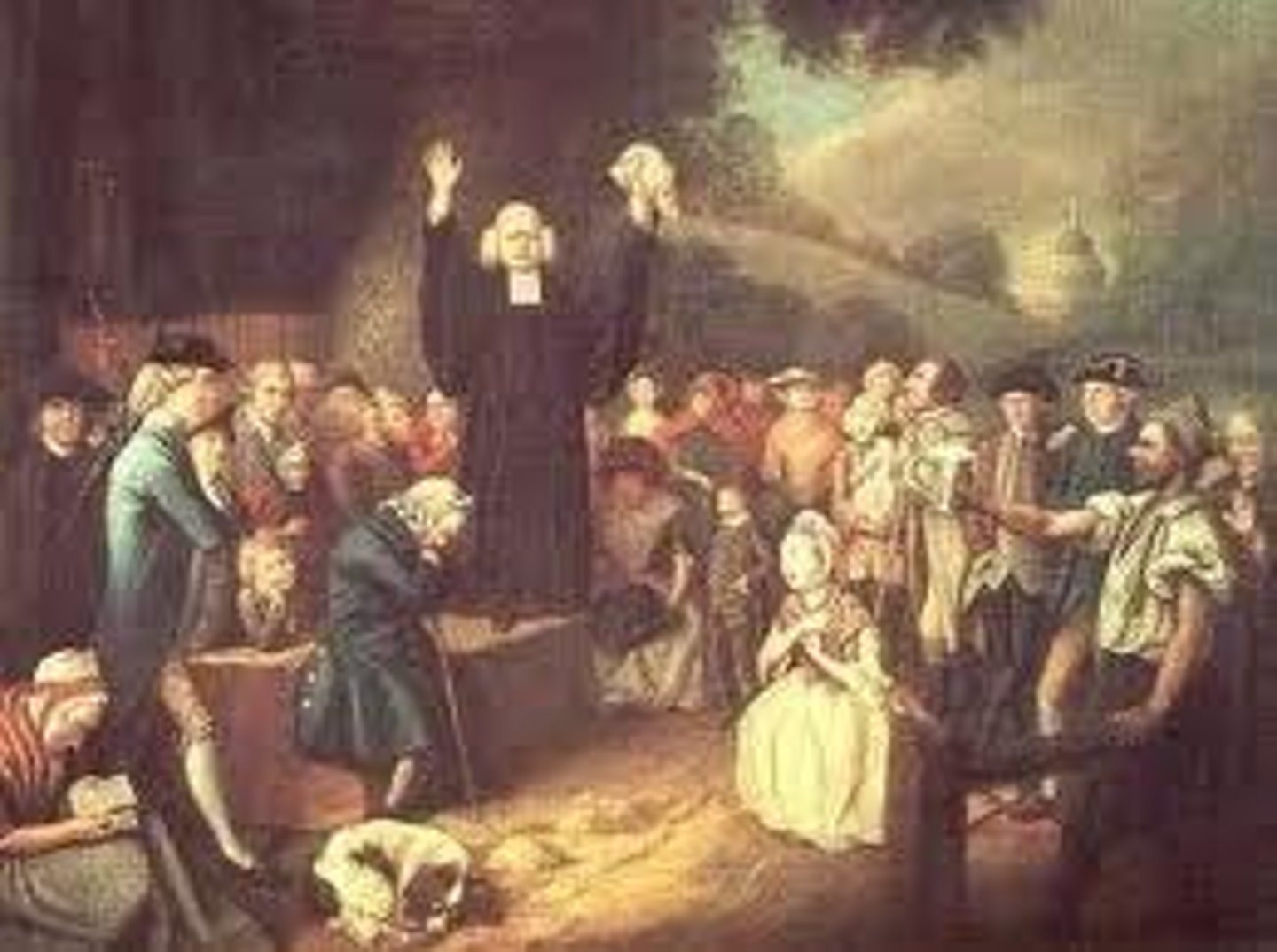
Borderland, or Middle Ground
This is a meeting place of peoples where geographical and cultural borders are not clearly defined. Numerous such places existed during the era of European conquest and settlement, including the contested Great Lakes region bordered by New Netherland, the Haudenosaunee, New France, and France's Algonquian and Wendat allies.